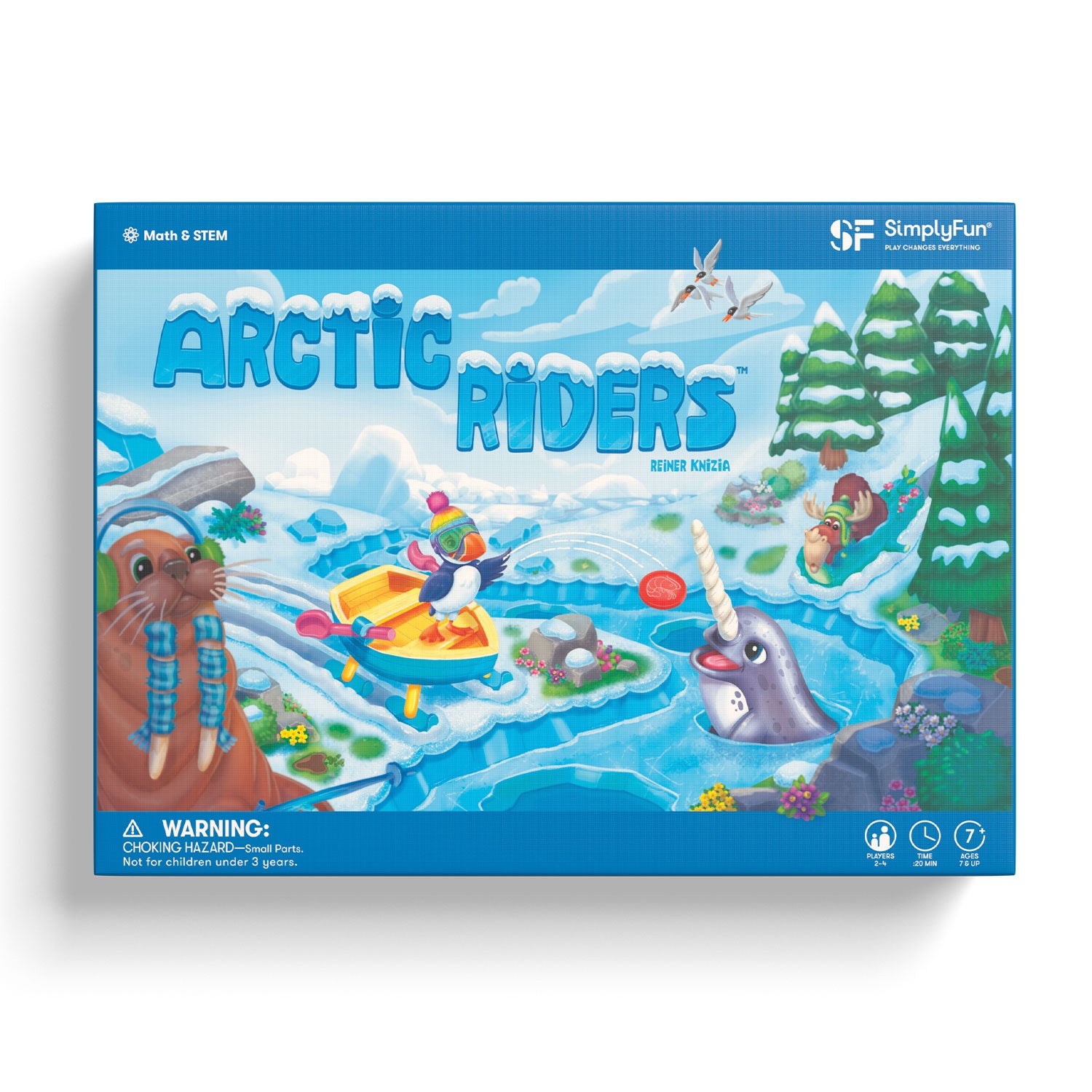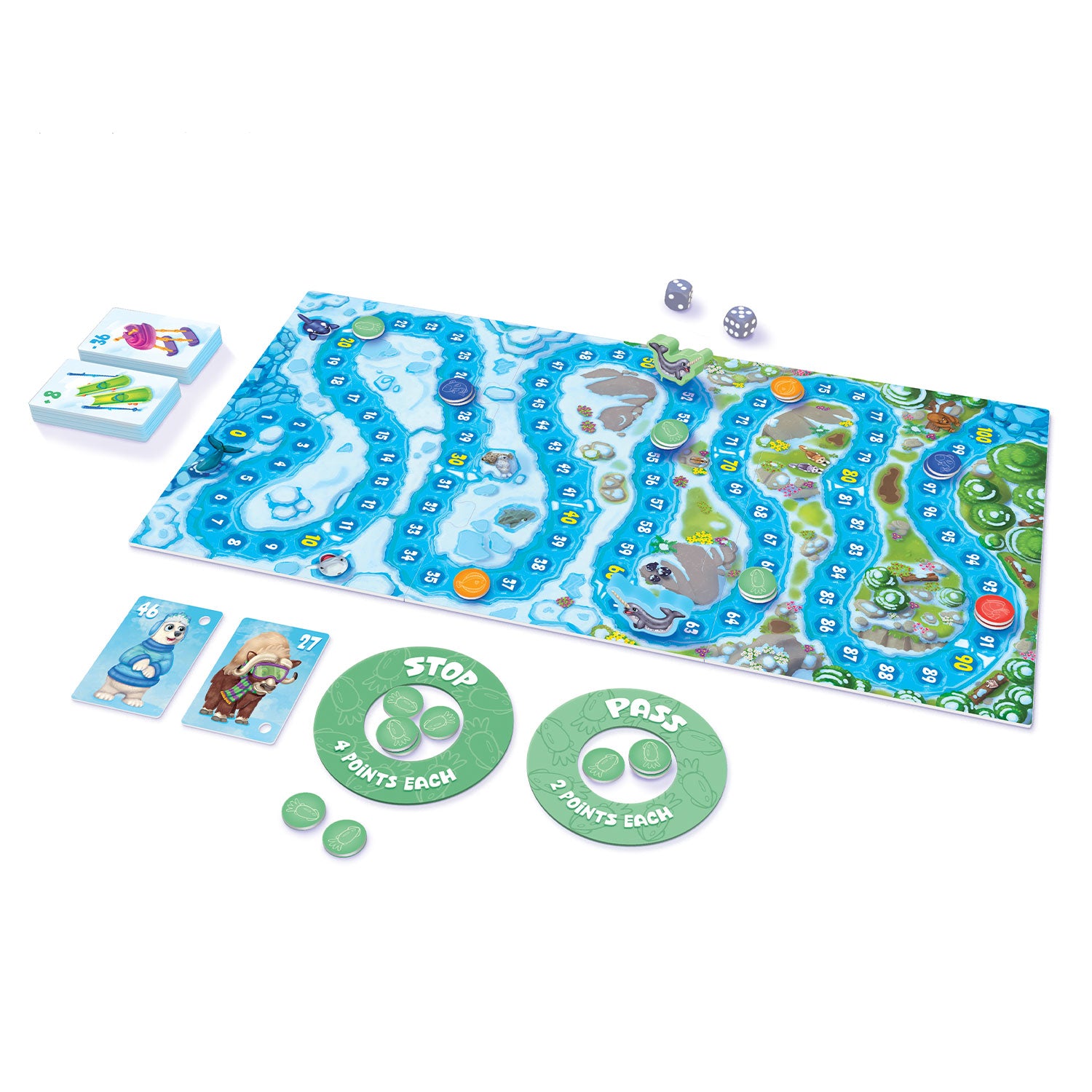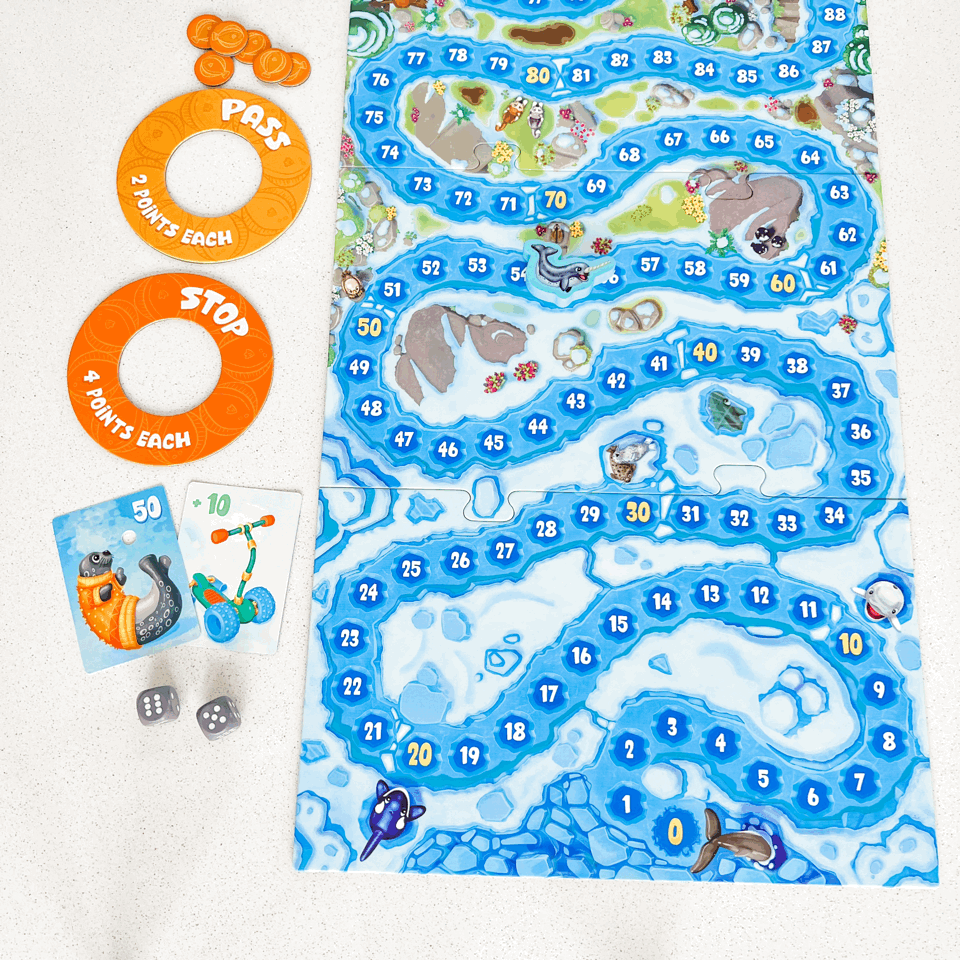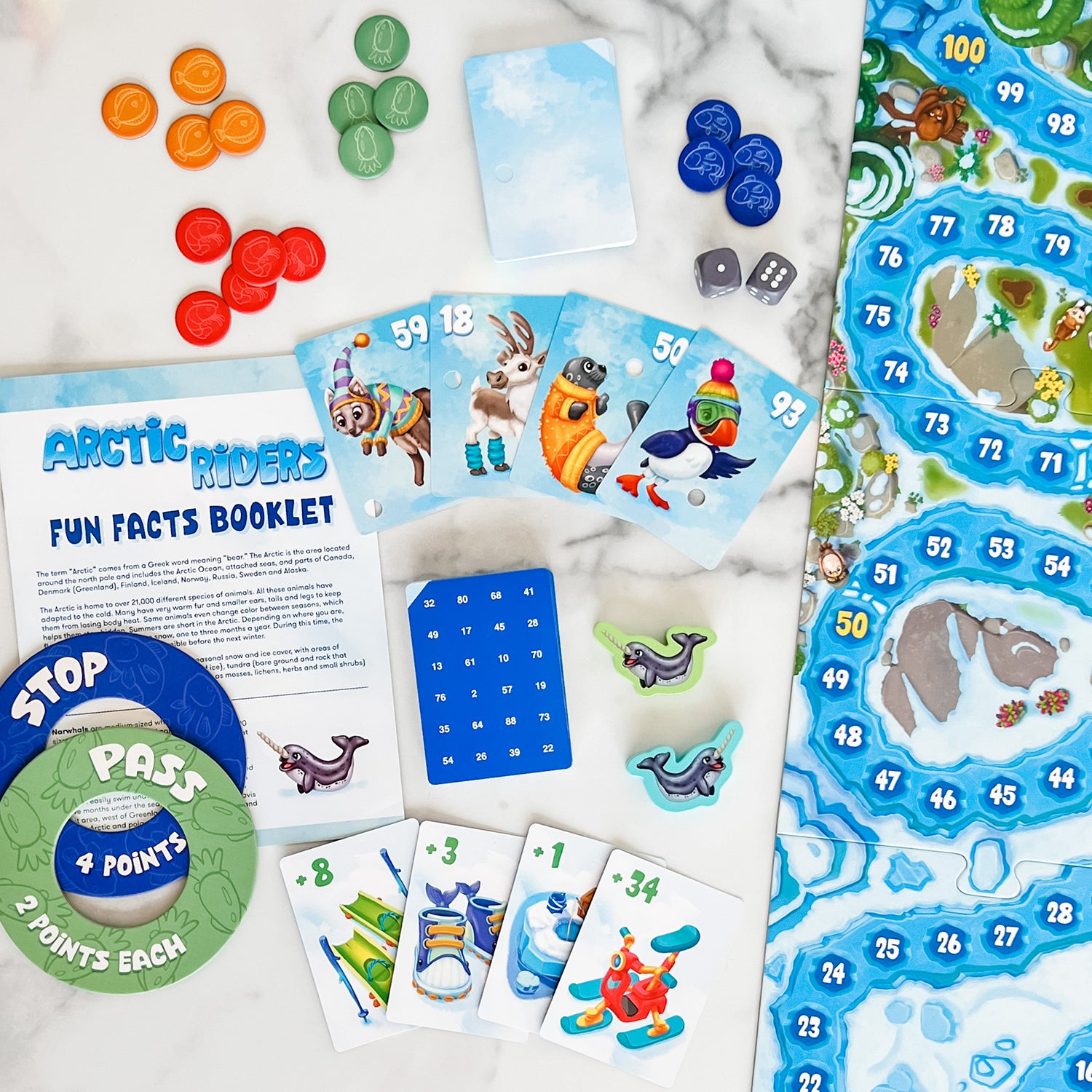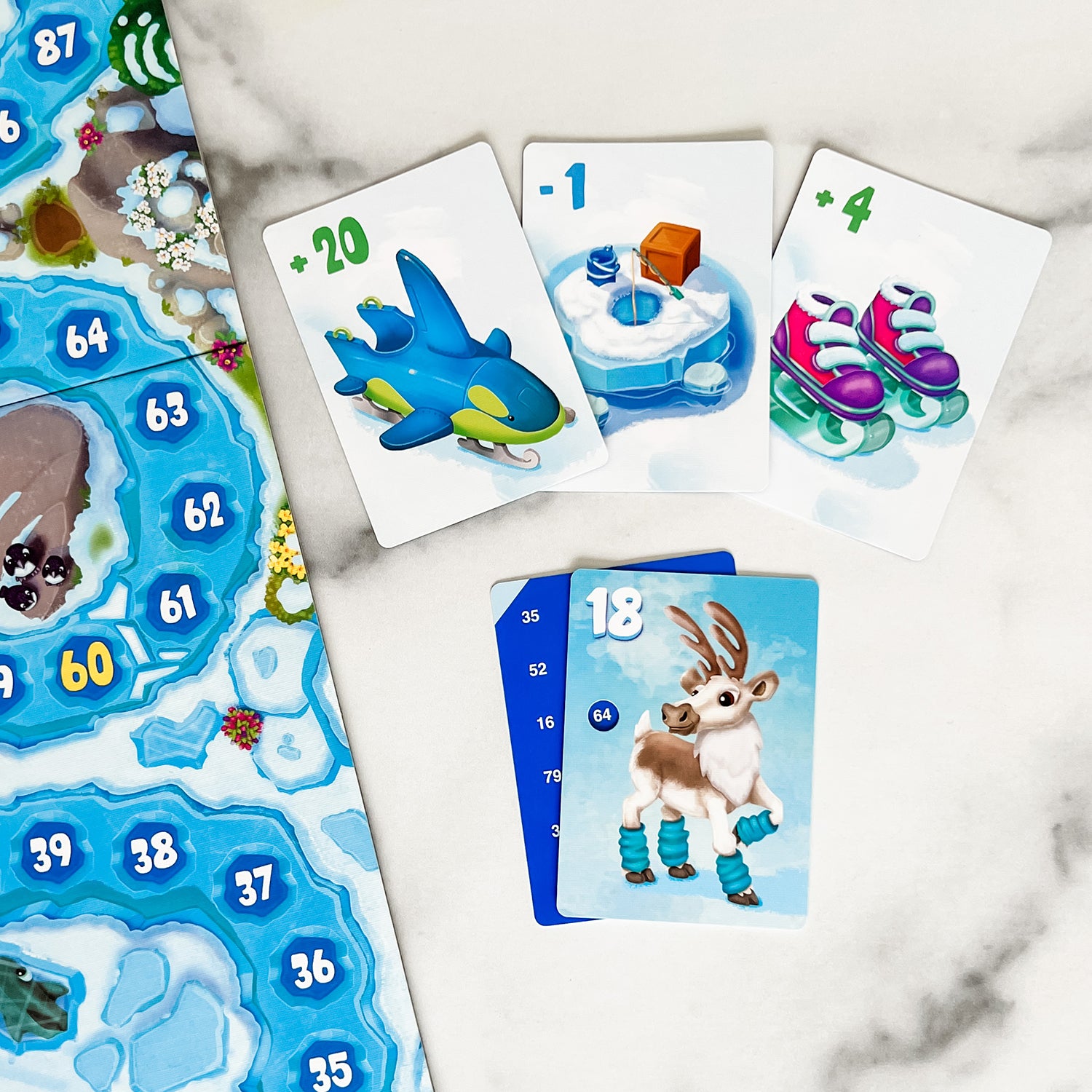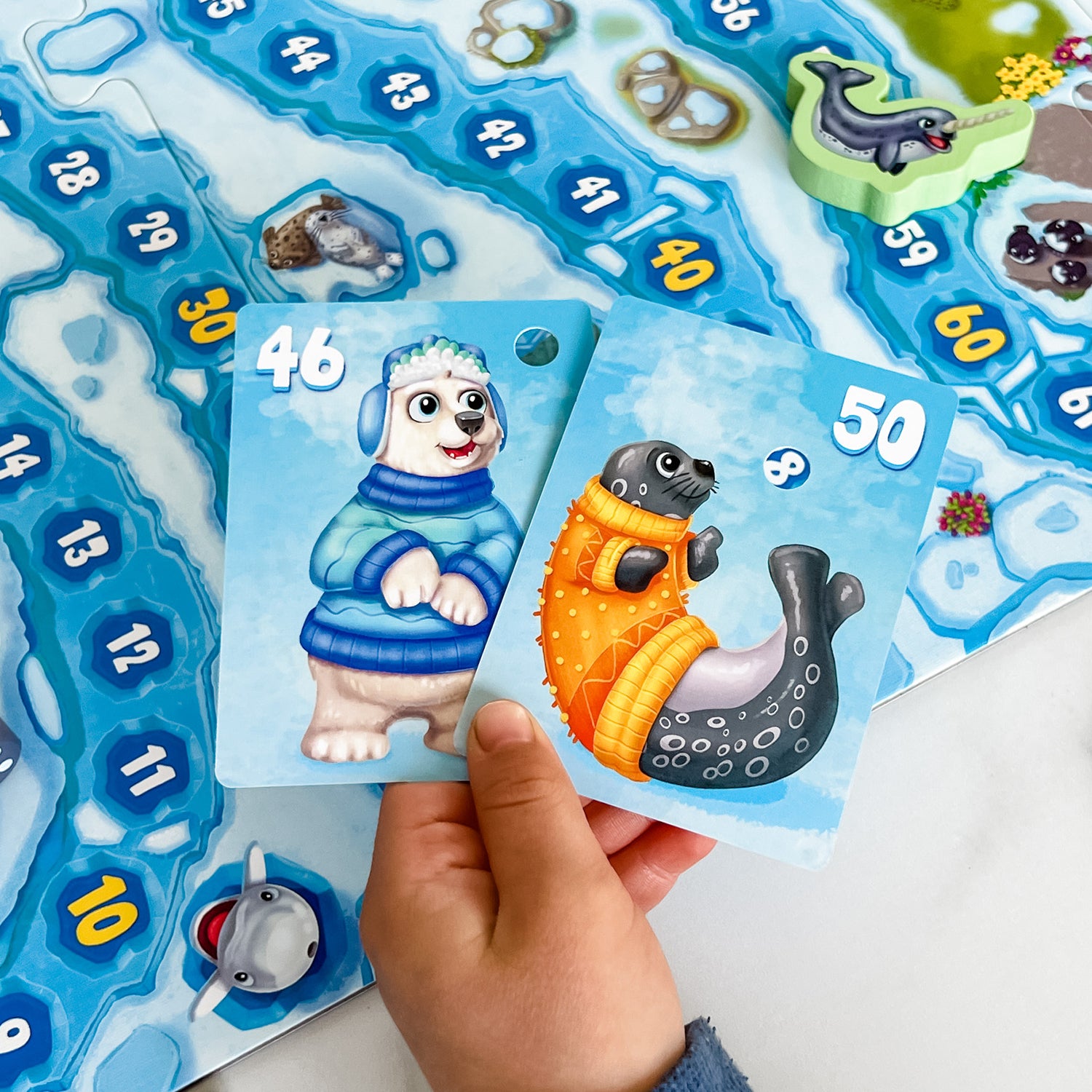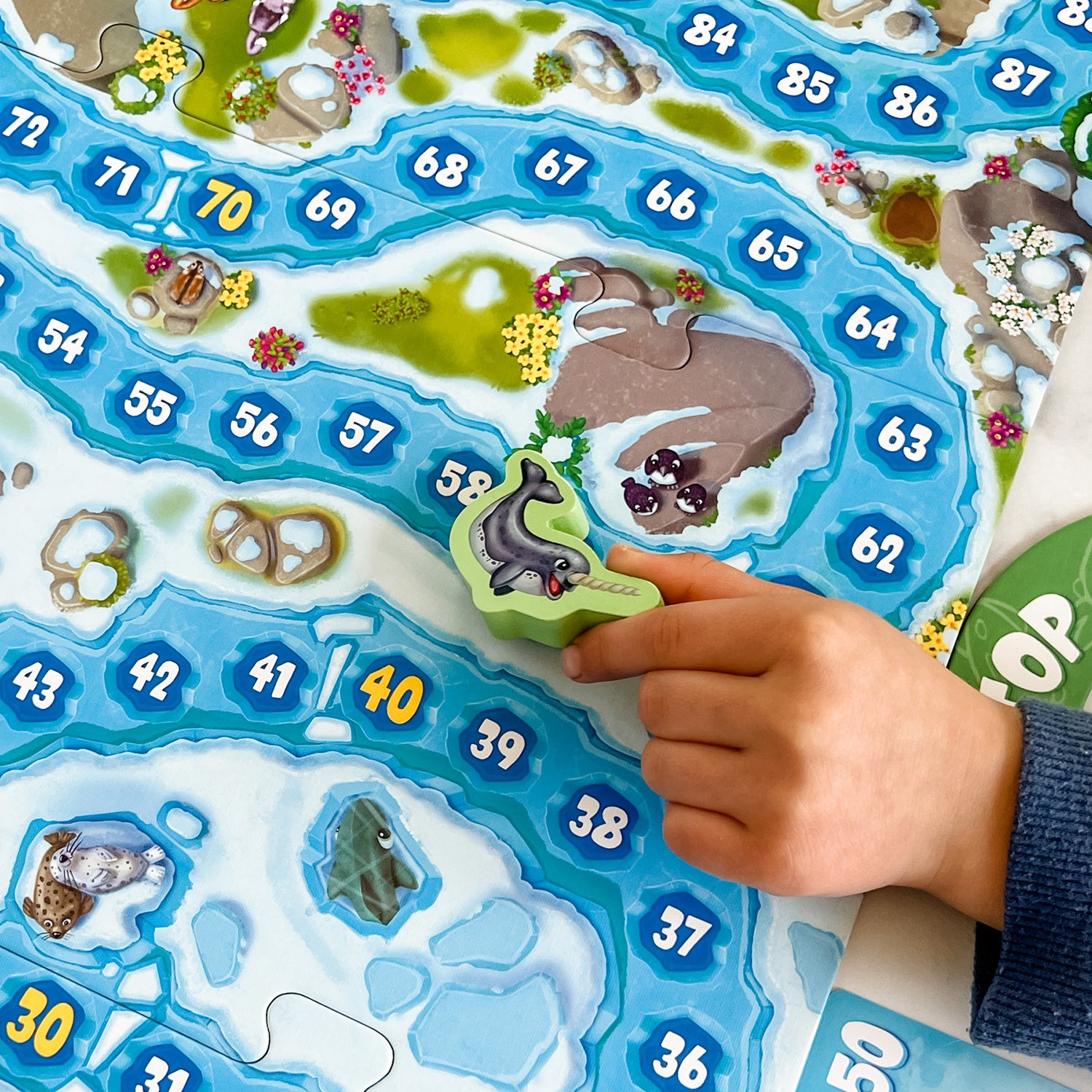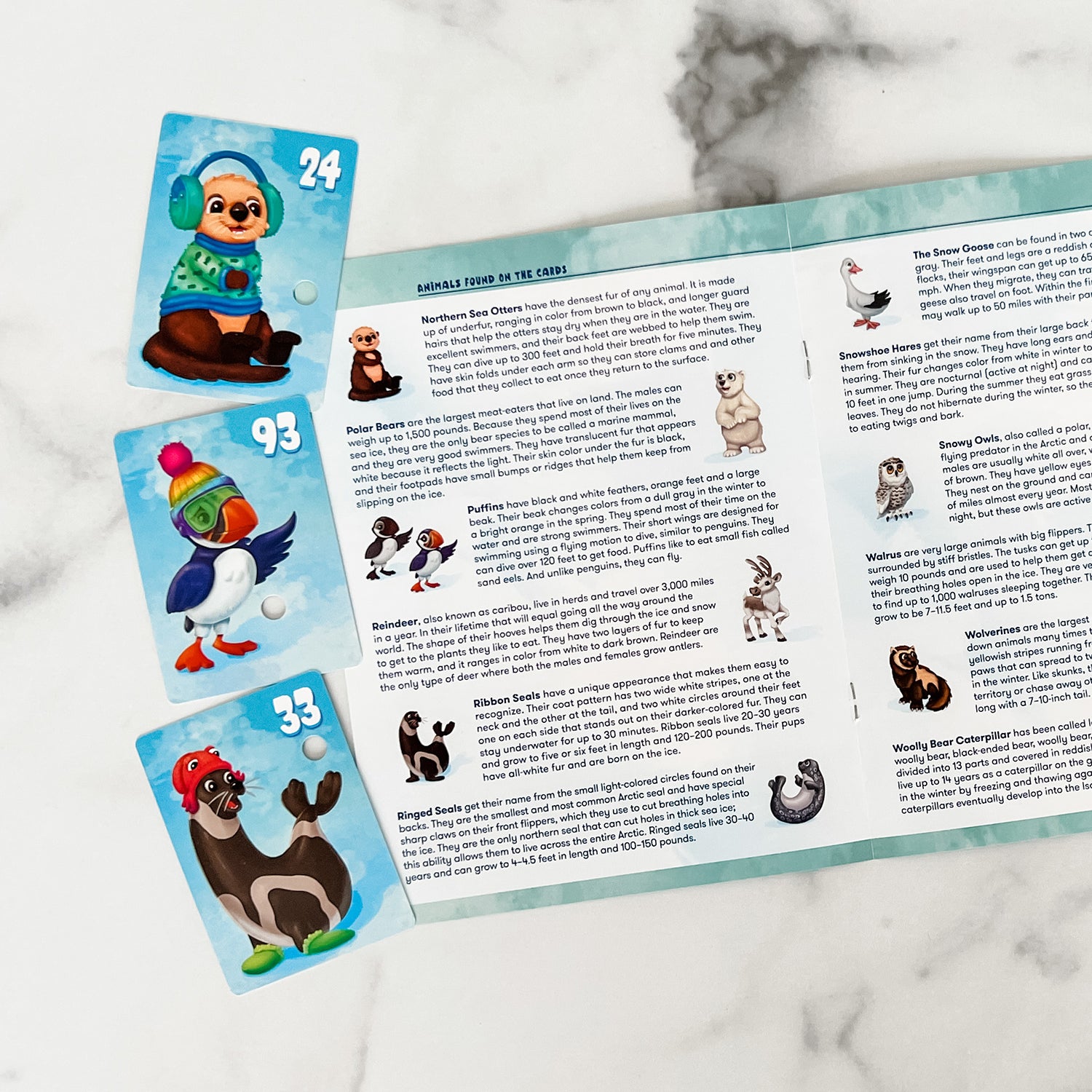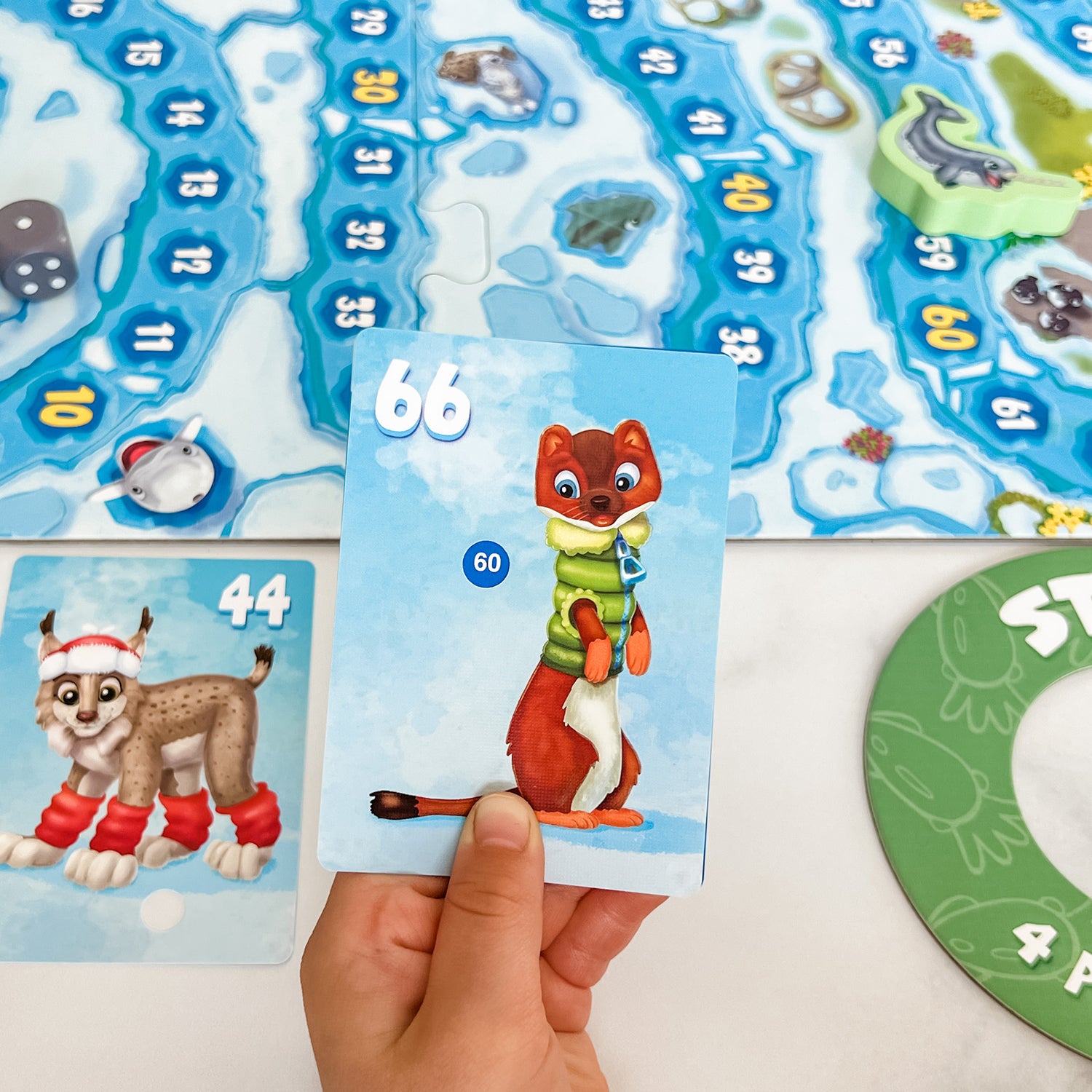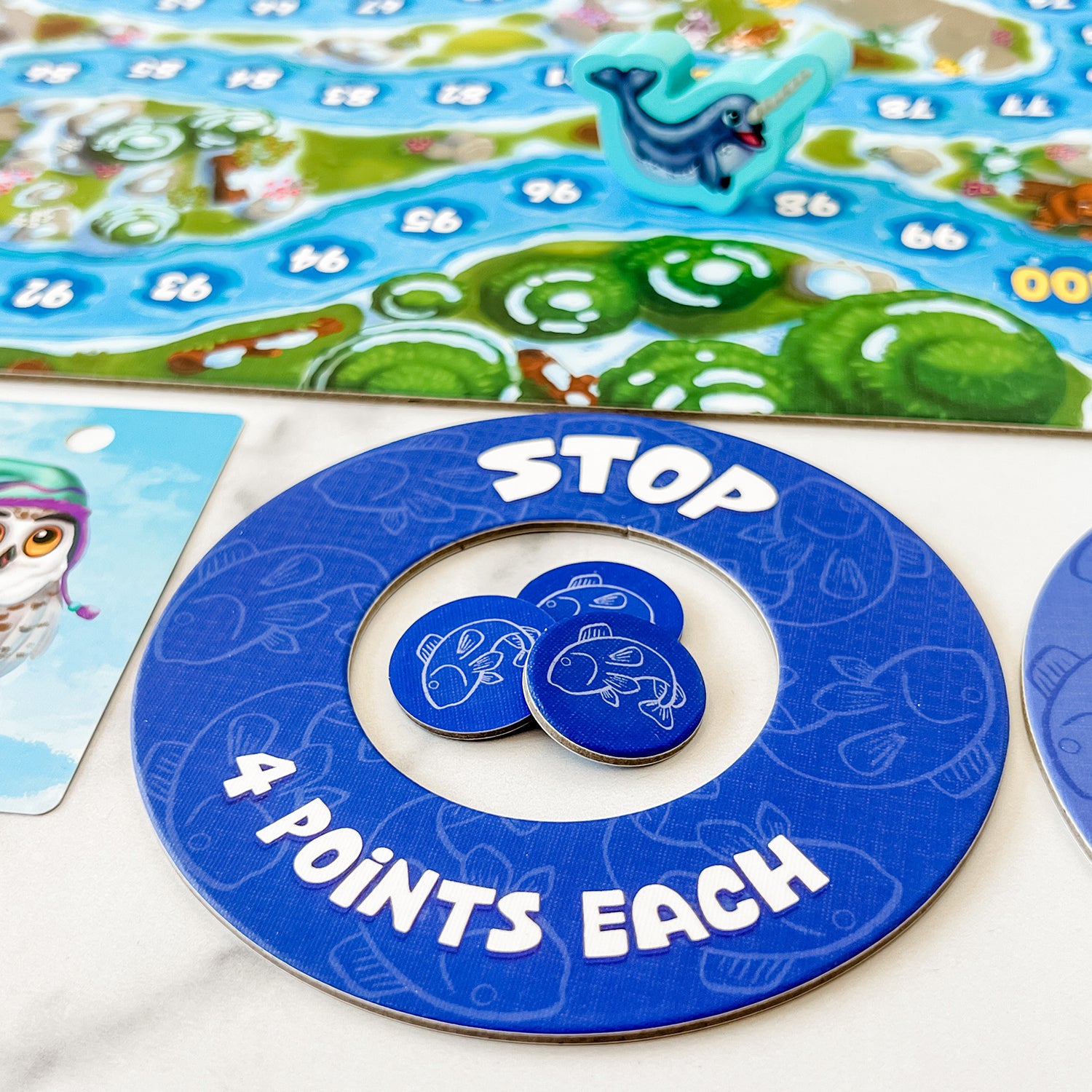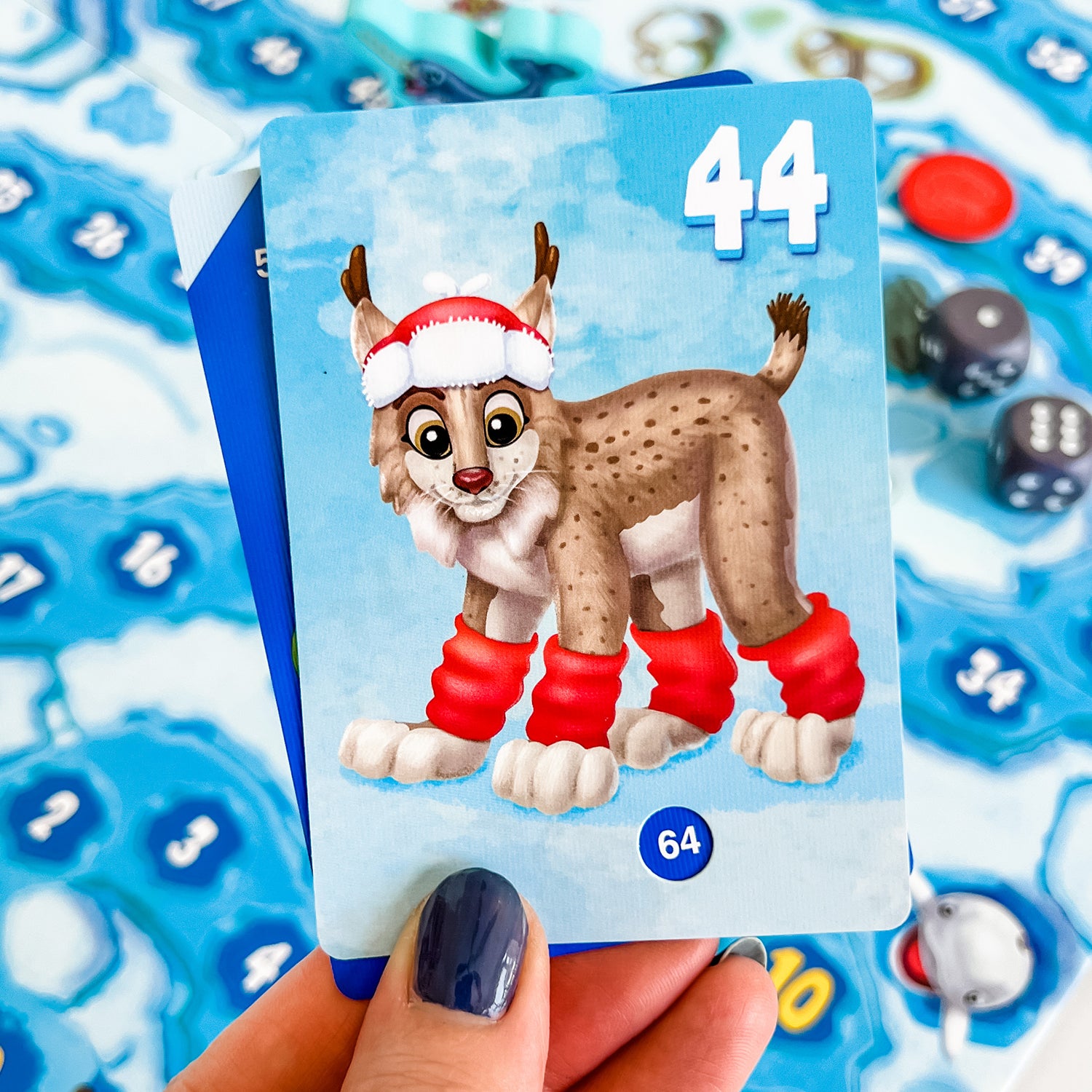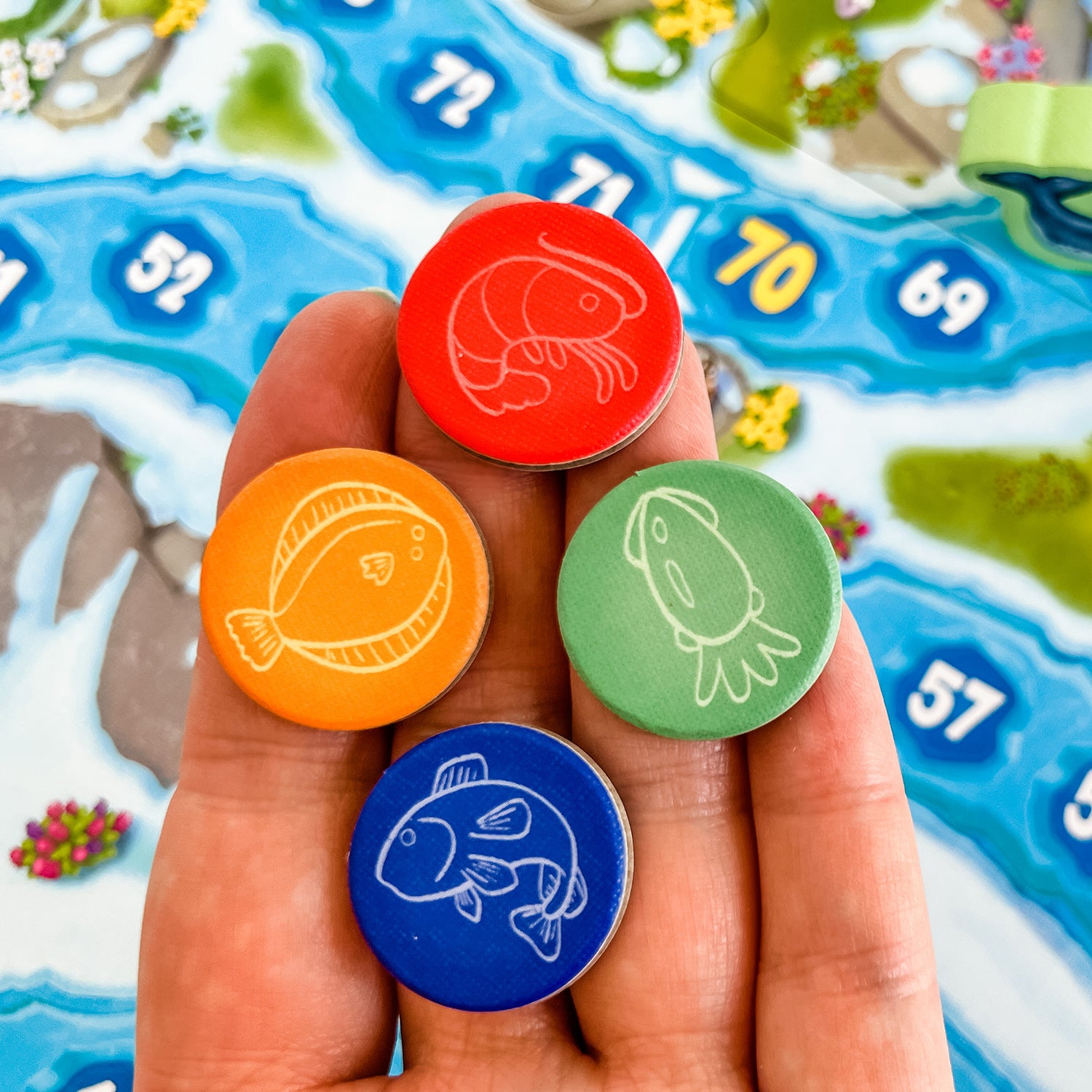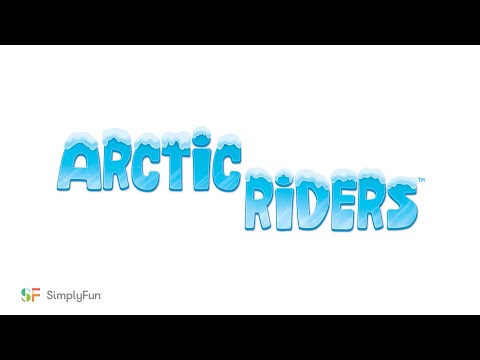Arctic Riders
Arctic Riders
2-4 players • 20 min • 7 & up
Focus: Addition & Subtraction
Couldn't load pickup availability
Skills: Addition & Subtraction, Decision Making
Game Includes
Game Includes
- 1 Gameboard
- 24 Animal Cards
- 40 Vehicle Cards
- 96 Treat Tokens
- 8 Scoring Rings
- 2 Narwhal Pawns
- 2 Six-sided dice
- 1 Fun Facts Booklet
- 1 Rules Booklet
Share
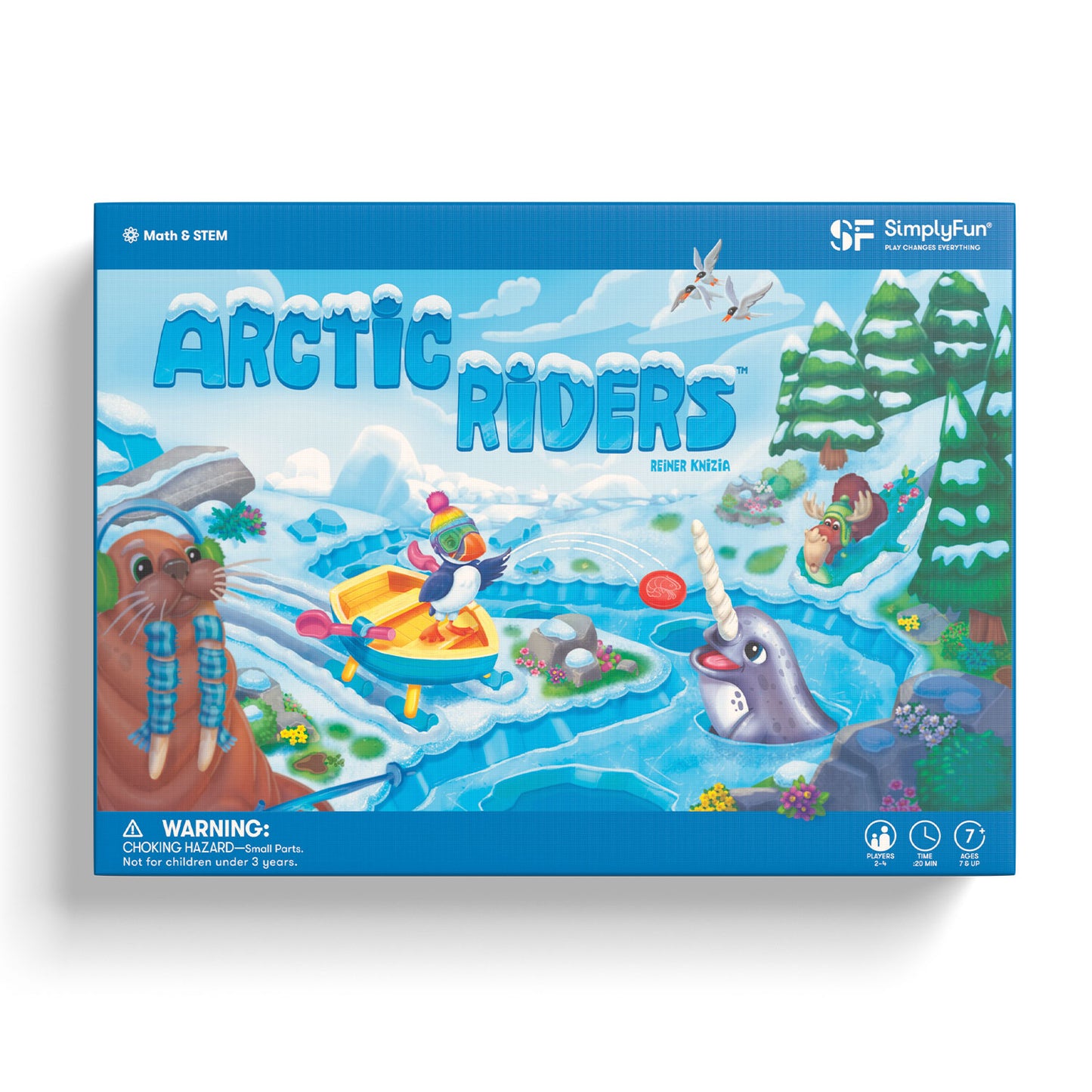
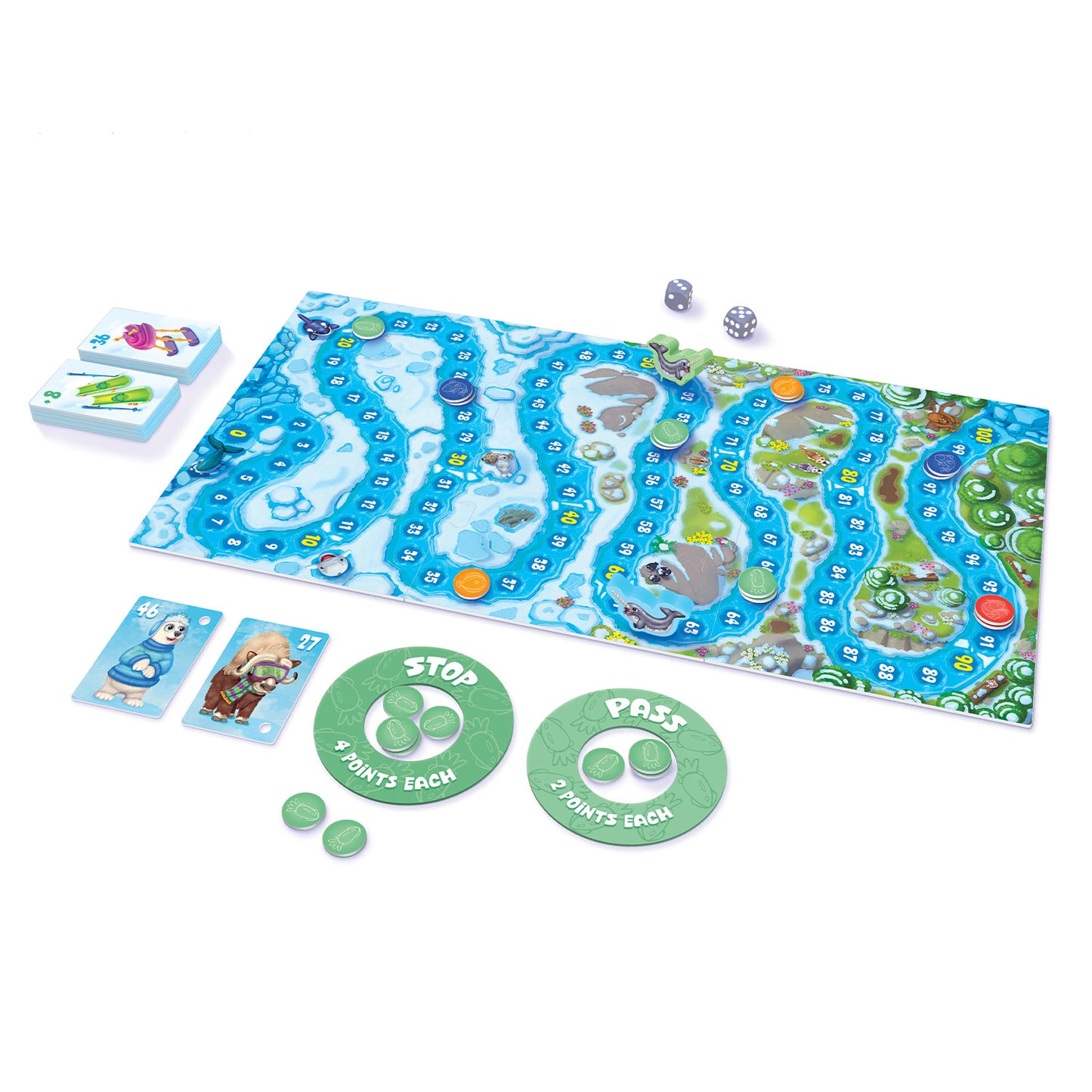
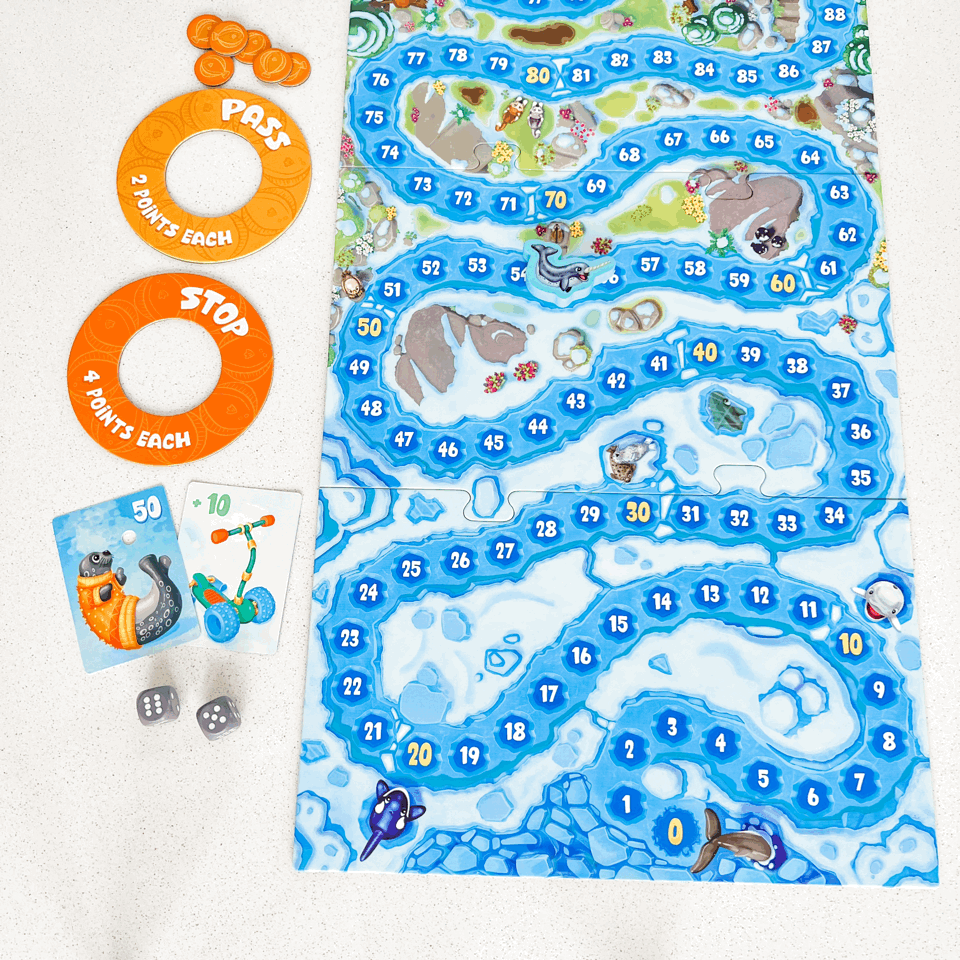
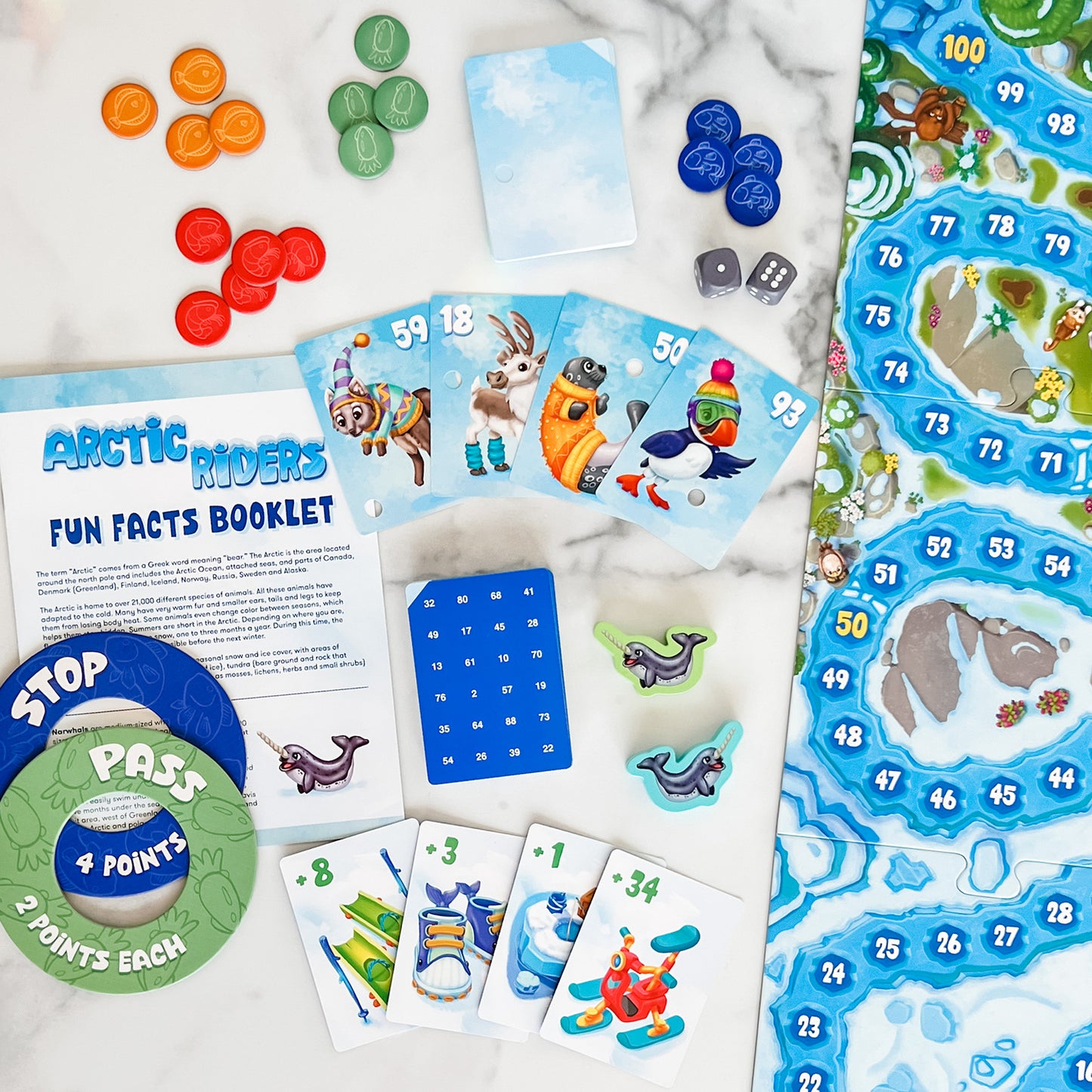
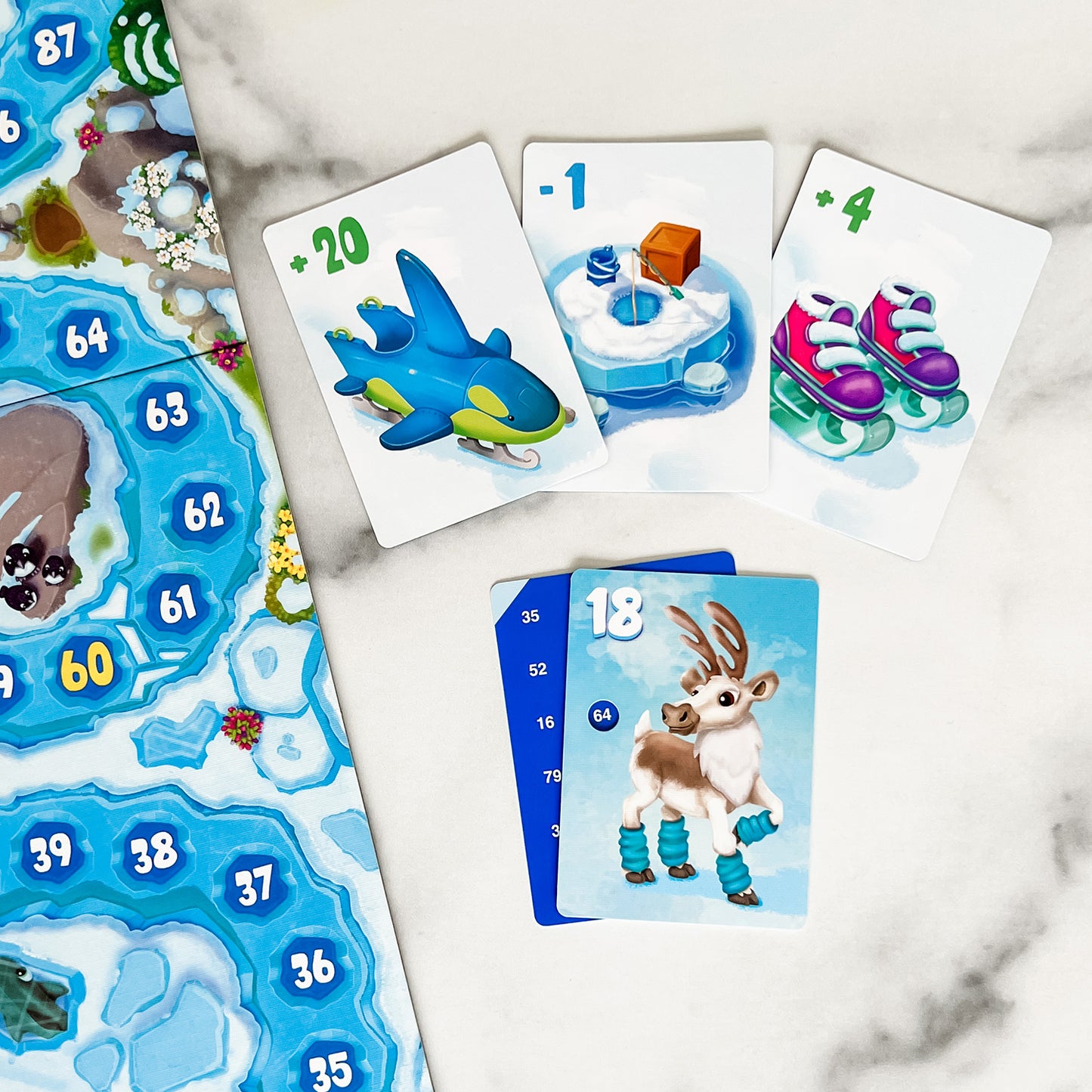
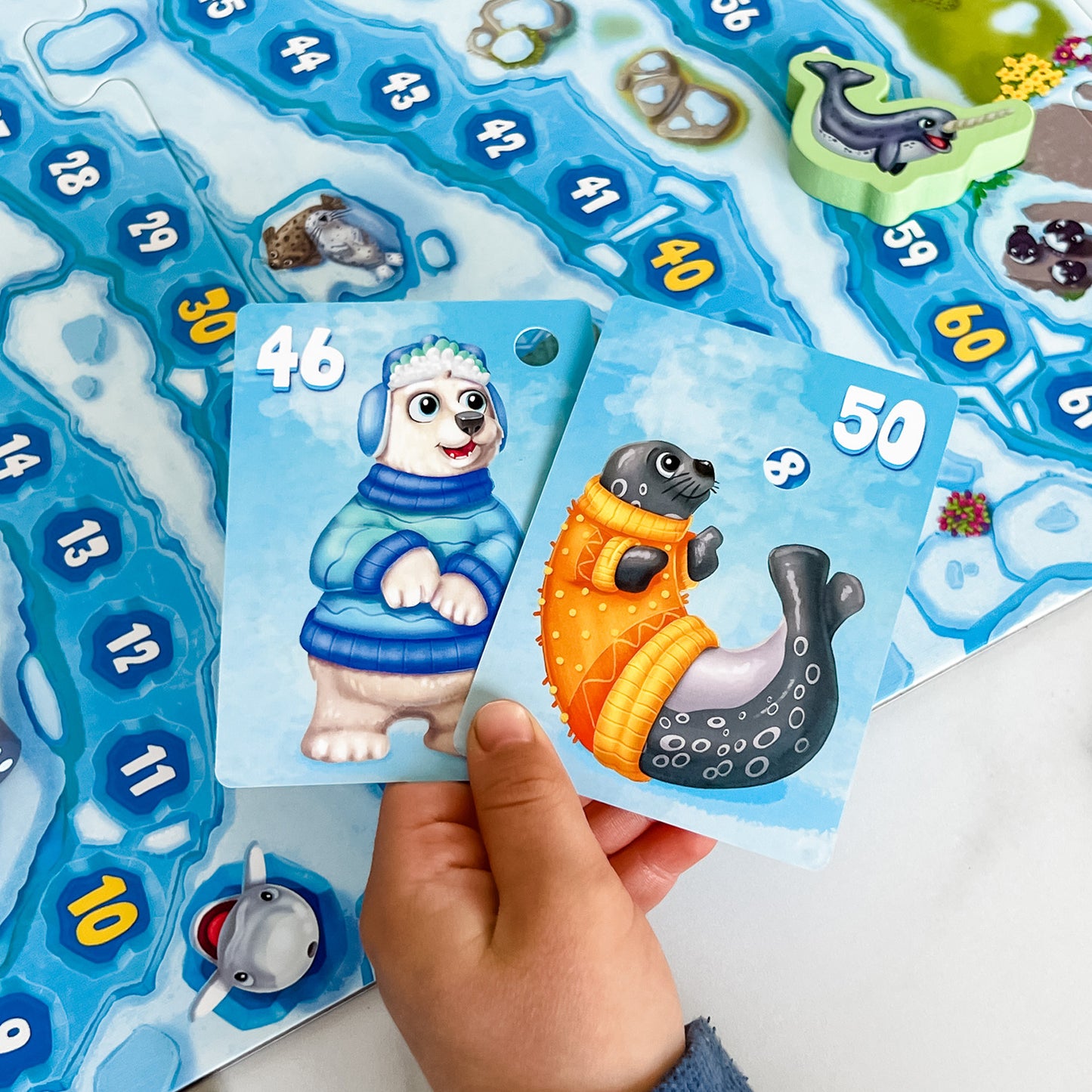
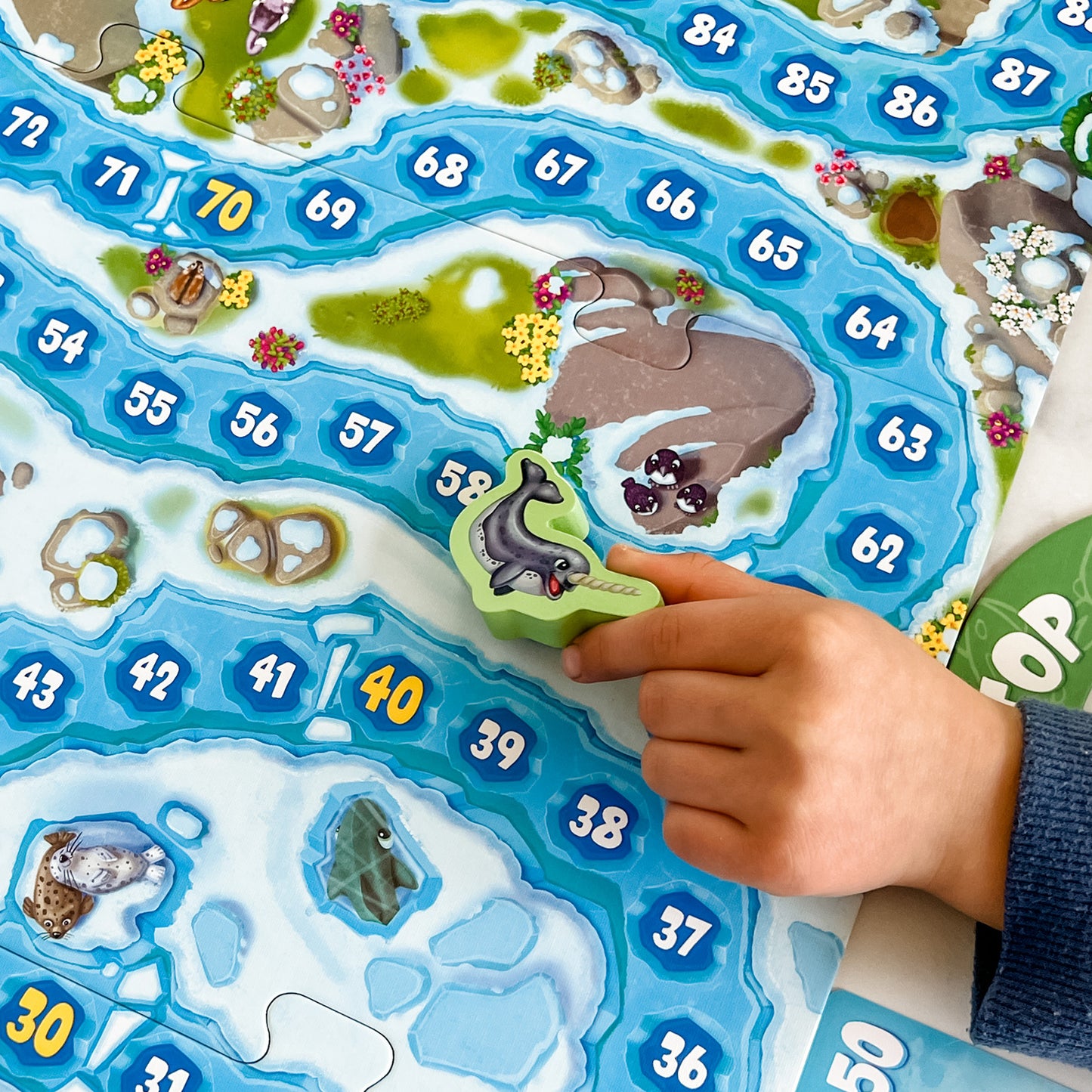
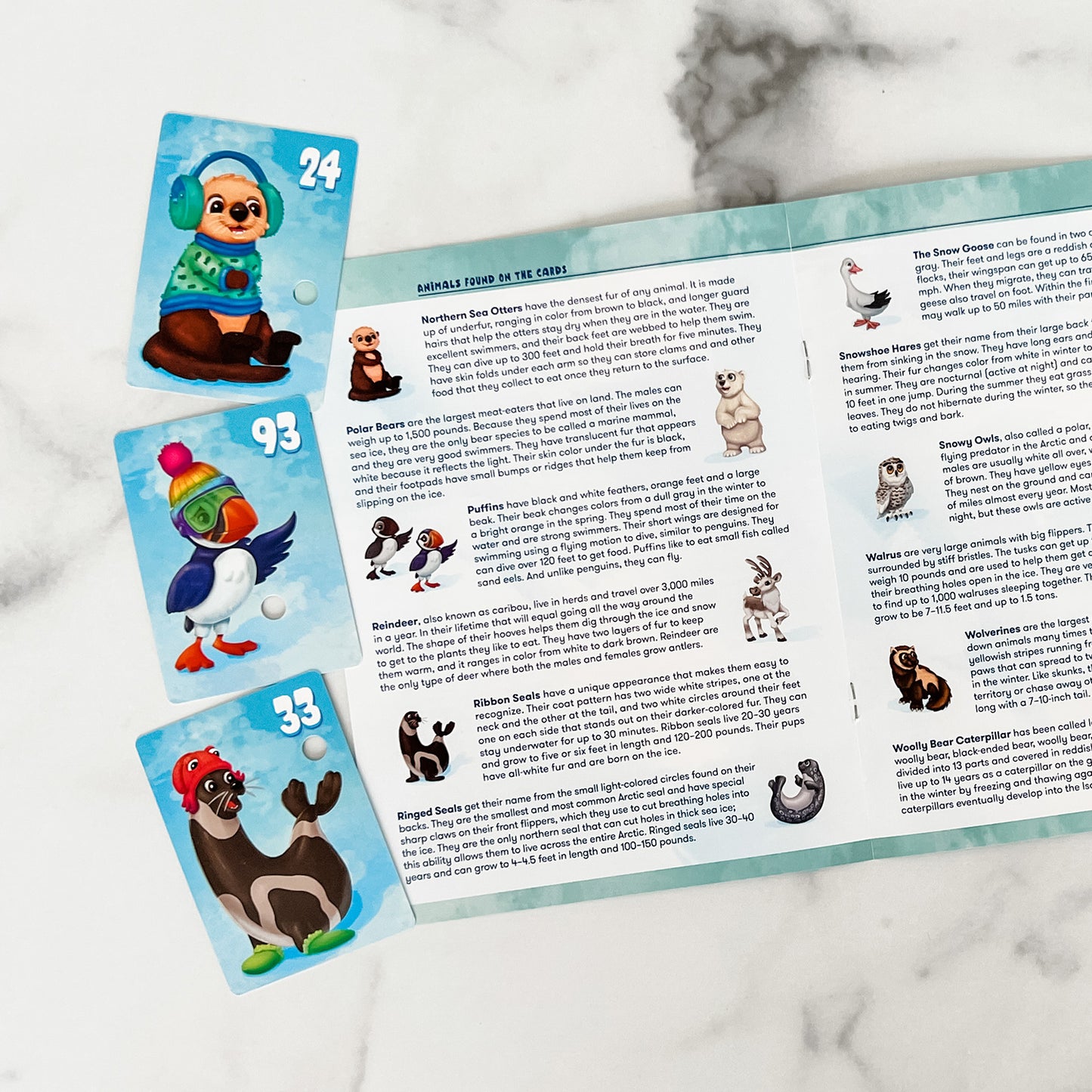
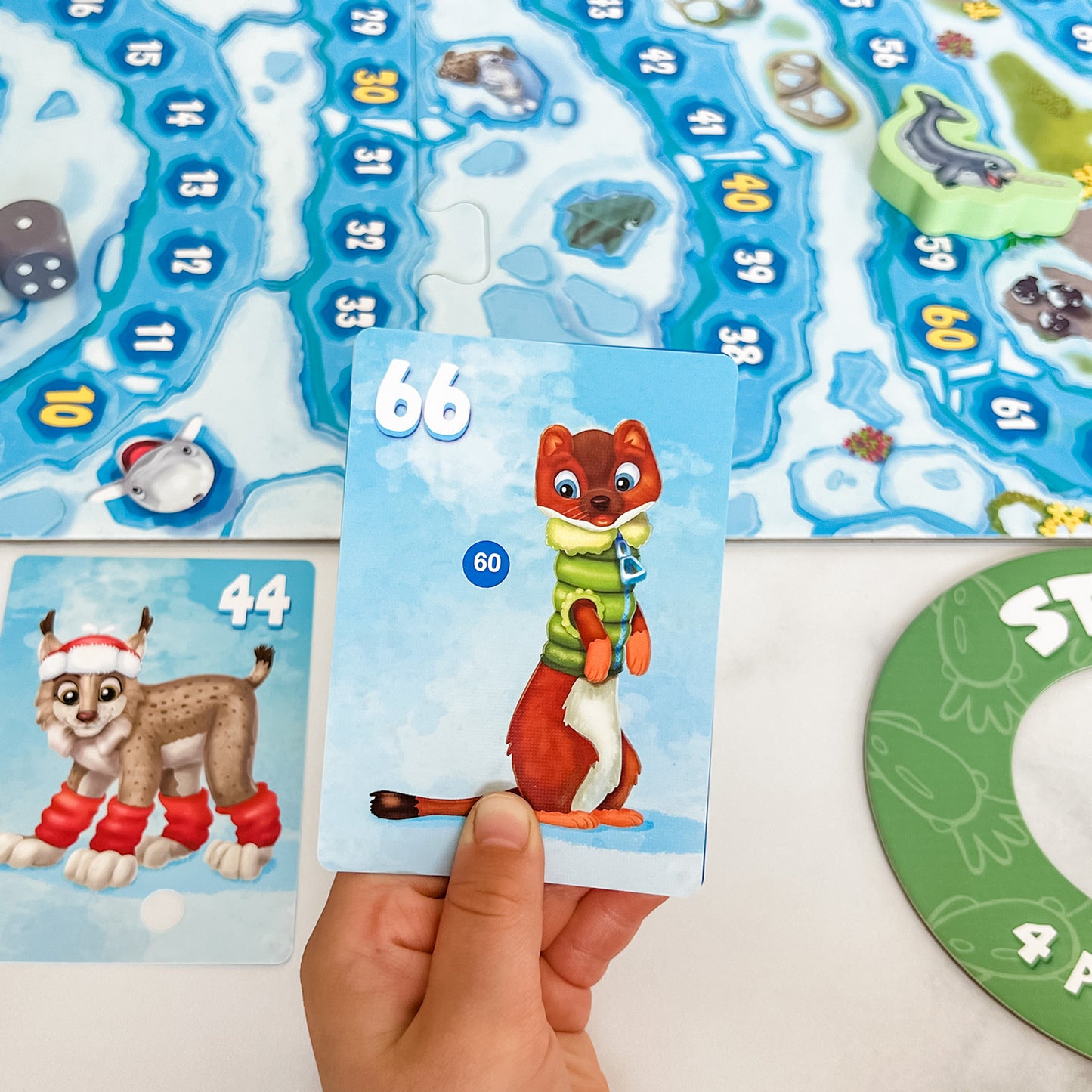
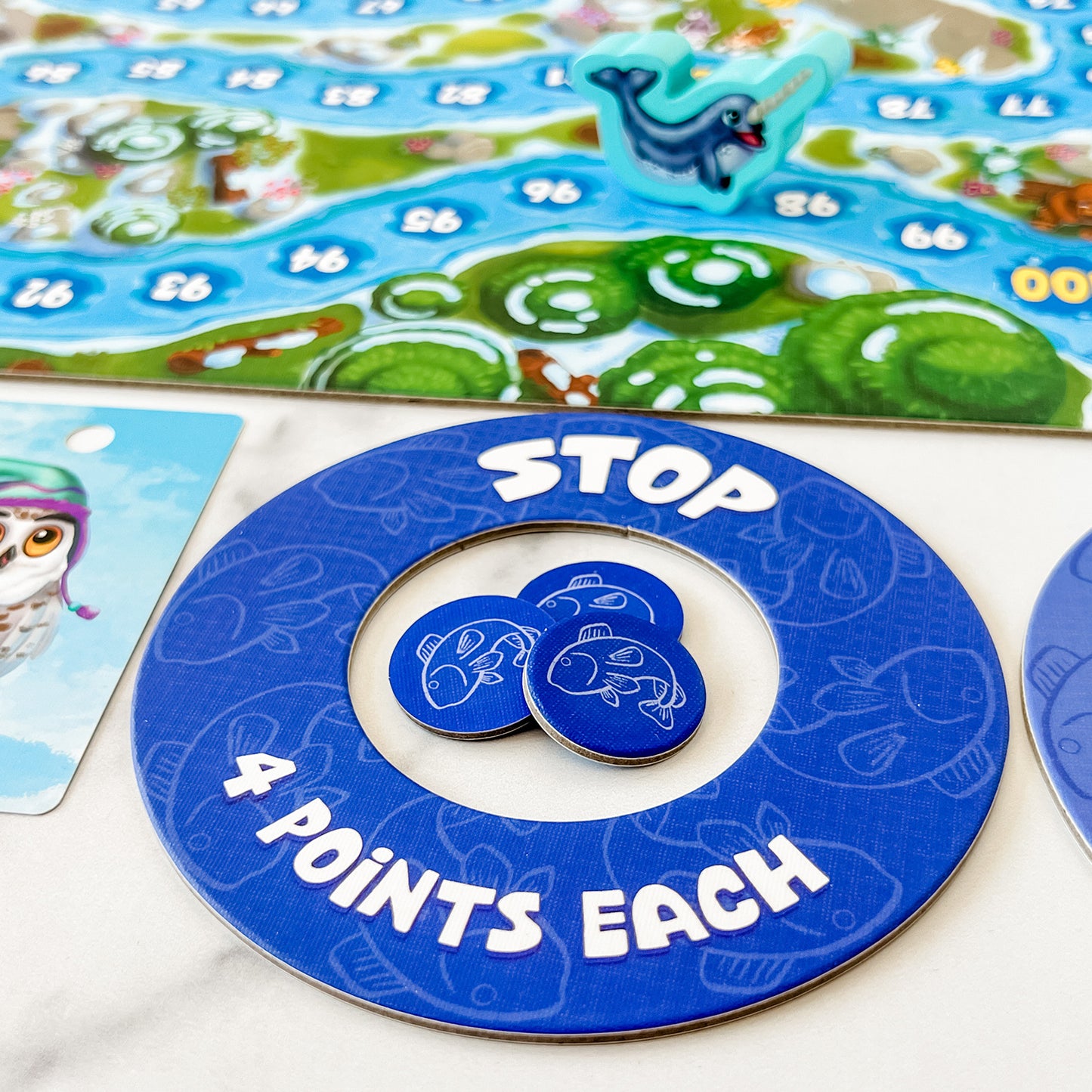
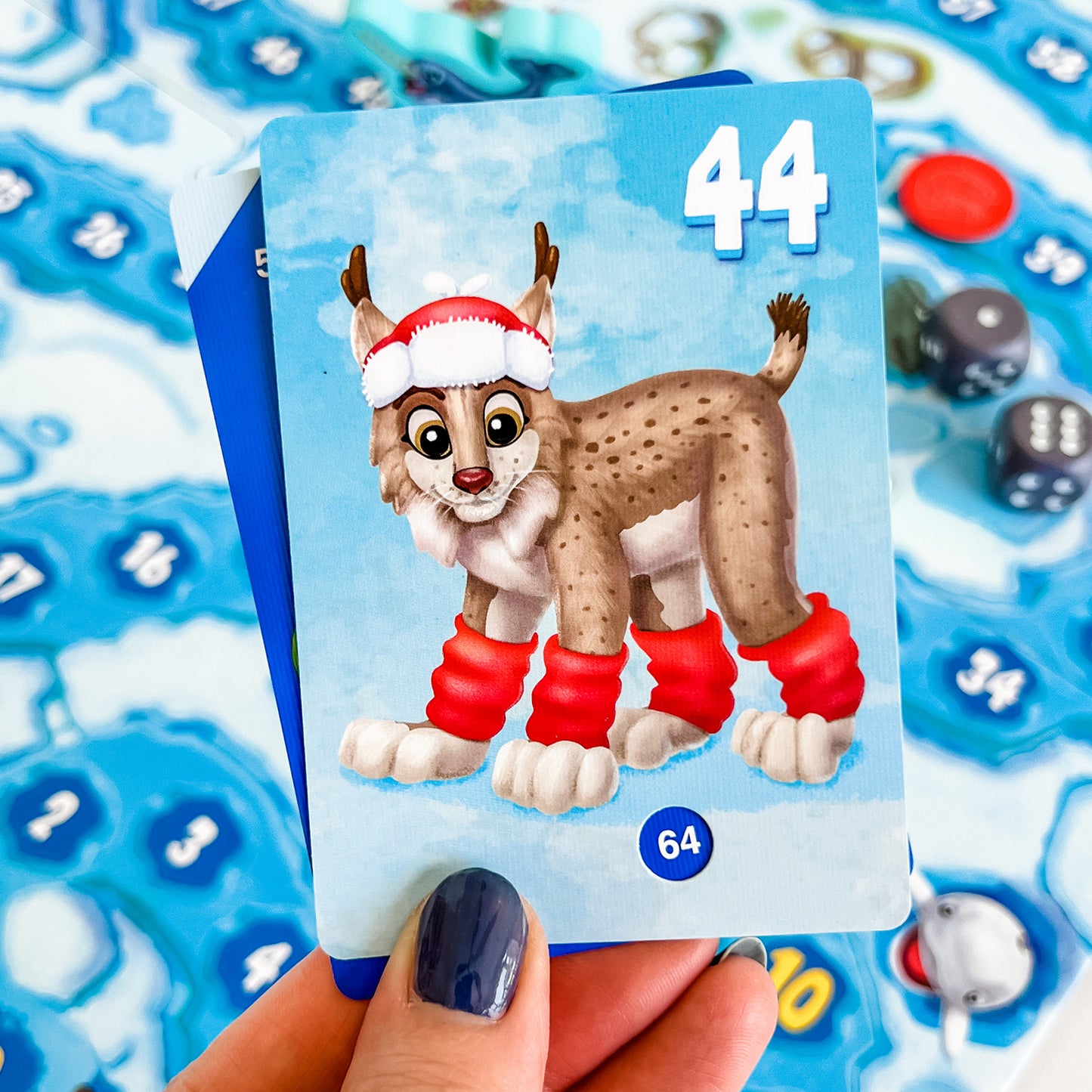
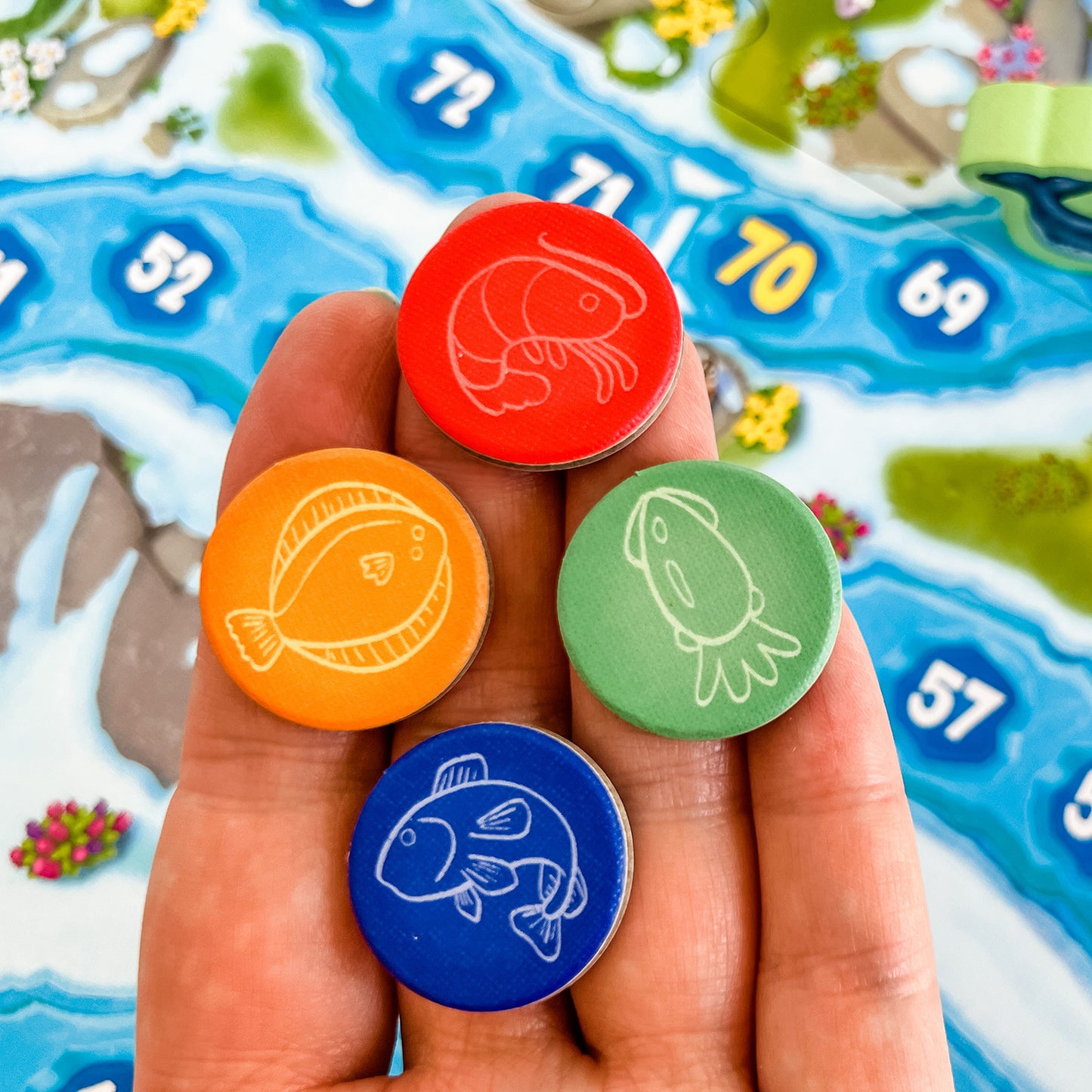



Collapsible content
How to Play
Educational Standards
Core Standard*: Math
Math
- Represent and solve problems involving addition and subtraction : Grade Level 2nd
- Add and subtract within 20. : Grade Level 2nd
- Understand place value. : Grade Level 2nd
- Use place value understanding and properties of operations to perform multi-digit arithmetic. : Grade Level 3rd
Skills
Explore
What Does Child Do To Use Skill In The Game?
Players need to look closely at board for location and direction of narwhals before making their moves. They also need to look at their 2 animal cards and the 2 face-up vehicle cards to begin identifying math problems to solve.
How Parents Can Assist Learning
As children are looking at the board, parents may want to remind children that the narwhals turn around and go back after they reach zero or 100.
Also, because you can score on anyone's turn, parents may want to encourage children to keep exploring during other players' turns. This helps build focus and attention.
Learning Implications and Educator Support
Arctic Riders is great for learning single and double-digit addition and subtraction, as well as core thinking skills like attention, focus and decision-making.
In order to excel at the game, children need keep exploring the gameboard to track the movements of the narwhals relative to the location of and options for playing tokens.
Determine
What Does Child Do To Use Skill In The Game?
Players need to complete four math problems and, based on the results, play or do not play tokens on the gameboard. Additionally, after they role the dice, they determine which die to use to move each narwhal. Lastly, players determine whether to pick up tokens based on the movements of the narwhals.
How Parents Can Assist Learning
If children are not yet strong at mental math, give them paper and pencil or pen so they can do addition and subtraction.
Learning Implications and Educator Support
Arctic Riders gives children a chance to do four math problems on each turn, which is great for building addition and subtraction proficiency. If children are not yet strong at mental math, give them paper and pencil or pen so they can do addition and subtraction.
Decision-making is the primary thinking skill developed playing Arctic Riders as players need to decide which math solution to choose, where to move narwhals and whether they scored any points.
Compare
What Does Child Do To Use Skill In The Game?
Players compare the results of the four math problems to determine which answer to use for placing their tokens. They also compare where others' tokens are located in order to decide where to move a narwhal.
How Parents Can Assist Learning
Prior to choosing a math solution in order to place tokens, it may help to encourage children to "Wait. Look. Think." This will help them spend time enough time considering implications of different options.
This will also help with impulsivity and planning. Using such verbal cues can give children a model for approaching future play as well as complex life choices.
Learning Implications and Educator Support
Prior to choosing a math solution in order to place tokens, it may help to encourage children to "Wait. Look. Think." This will help them spend time enough time considering implications of different options.
This will also help with impulsivity and planning. Using such verbal cues can give children a model for approaching future play as well as complex life choices.
Remember
What Does Child Do To Use Skill In The Game?
Players need to remember how to do addition and subtraction using single and double digits (e.g. 5 + 5 = 10).
Predict
What Does Child Do To Use Skill In The Game?
Based on position and direction of narwhals, players can predict where they will move.
Plan
What Does Child Do To Use Skill In The Game?
Arctic Riders involves some planning as players try to places tokens in most favorable positions relative to the location and direction of narwhals.
Learning Implications and Educator Support
Because players know the direction narwhals are moving, they can plan ahead by placing tokens in front of narwhals.
Solve
What Does Child Do To Use Skill In The Game?
As other players score and place their tokens, you need to be more strategic in deciding where to place yours and move the narwhals.
How Parents Can Assist Learning
Parents can encourage children to take turns helping each other figure out where to move their dog and which cards they need to achieve their goal. Additionally, ask the children to try to make trades that help each other achieve the group's goals.As with the comparing skill, it may help to encourage children to "Wait. Look. Think" later in the game. This will help them spend time enough time considering implications of different options which often becomes more complex as the game proceeds.
Learning Implications and Educator Support
Solving skills in Arctic Riders is an advanced form of decision-making. Notably, as more tokens are on the board and more scoring has occurred, children need to think more about the implications of moving a narwhal. For example, will moving a narwhal make other players score points or avoid scoring point, while at the same time allowing you to score?
Similarly, deciding where to place your tokens becomes a more complicated choice as others place and remove tokens from the board.
*Data compiled from CCSSI ELA Standards, WA Science Standards, and Washington Social Studies Standards
Special Needs
Cognitive
Suggestions for How to Modify Play Experience
Children with cognitive delays may have difficulty with the math portion of the game. Play in partners. They can work on the math problem together and each can be responsible for moving one narwhal.
Use the numbers on the board to illustrate the adding or subtracting process. For example, for 24+ 33, start on space 24 and move up 3 tens, then 3 more spaces. For 89- 51, start on space 89, move down 5 10s and then one more. This process helps the child visualize and understand the process of addition and subtraction.
Communication
Suggestions for How to Modify Play Experience
Ask the players why they chose the problem they did and to verbalize how they got the answer to their math problem.
Encourage communication about each players moves, including why they chose to move each narwhal as they did. This will help other players think about strategy.
Sensorimotor
Suggestions for How to Modify Play Experience
Arctic Riders is a path game with small spaces for moving the narwhals and placing the tokens. In addition, manipulating cards to reveal answers requires some dexterity. To assist the child with fine motor problems, playing with a partner is recommended. Decisions can be made together, and the player without fine motor concerns can assist with moving tokens and narwhals, and manipulating cards as needed.
If the child has difficulty writing numbers, provide manipulatives representing 10's and 1's for the child to manipulate to determine the answers to addition and subtraction problems.
Social Emotional/Behavioral
Suggestions for How to Modify Play Experience
If a child is not good at two digit math, the game may be frustrating and cause behavioral issues. Playing with a partner is again recommended, as the partner can help explain the math. The correct answer key can help the child build confidence, and gaining tokens will boost positive affect.
Vision
Suggestions for How to Modify Play Experience
Arctic Riders is not recommended for blind children or children with low vision. The board is visually complicated and it would be difficult for the child with low vision to see the detailed numbers. They would also not be able to see the answer key on the cards, as they are very small.
Hearing
Suggestions for How to Modify Play Experience
Point to the cards as visual aids, along with gestures, for making trades.Children with hearing loss should be able to play Arctic Riders if the game is explained by visual demonstration of each step along with the child reading the directions and watching the video explanation.
*Data compiled from CCSSI ELA Standards, WA Science Standards, and Washington Social Studies Standards
Autism
Autism Strengths & Interests
Short Summary of Strengths & Interests
- Addition and subtraction
- Decision making
- Strategy
Is good at matching visual items
Is This Game Appropriate? No
Description
This game is not appropriate
Has a good memory for sensory details, including visual, touch, taste and smell
Is This Game Appropriate? No
Description
Sensory elements are not a component of the game.
Has a good memory for words, phrases and dialouge
Is This Game Appropriate? No
Description
Except for remembering the directions, Arctic Riders does not require memory for language.
Has a good memory for pictures, numbers and patterns
Is This Game Appropriate? Yes
Description
Children with autism may be interested in numbers, and Arctic Riders may be a good game for them. The little answer window may also be fun to manipulate to reinforce their responses.
Likes to put things in order or a sequence
Is This Game Appropriate? Yes
Description
Although the game is more about adding and subtracting, there is a sequence to follow with each turn. The two narwhals also go in opposite directions with one swimming up the number sequence to 100 and one swimming down the river sequence to 0. This gives players the opportunity to see a forward and backward sequence of numbers.
Learns through visualizing or "replaying" actions in their mind
Is This Game Appropriate? Yes
Description
Adding and subtracting often involve visualizing, pArcticularly when working with two-digit numbers. Players may visualize the tens and ones and manipulate them in their minds.
Likes activities with rules, such as math and phonics
Is This Game Appropriate? Yes
Description
In addition to the rules of the game, players need to utilize the rules of addition and subtraction and one-to-one correspondence for moving the narwhals. There are also rules related to placing the treat tokens and counting the final tokens earned.
Is very concrete and literal
Is This Game Appropriate? Yes
Description
Arctic Riders has both concrete and abstract elements. Movement of the treat tokens and the narwhals is very literal and concrete, while the addition and subtraction is abstract (unless supplemented by manipulatives).
Learns in small "chunks" (for example, phone numbers are 3 chunks of number xxx-xxx-xxxx that are combined together)
Is This Game Appropriate? Yes
Description
Because adding and subtracting in Arctic Riders is based on tens and ones, players may conceptualize the answers using these "chunks." For example, for the subtraction problem 74- 28, 74 can be conceptualized as 7 10s and 4 1's or or 6 10s and 14 1s. Thinking of it as 6 10s and 14 1s makes the subtraction easier. 6-2 = 4 and 14 - 8 = 6. Therefore, 74-28 = 46. Visualizing or thinking of the potential patterns of numbers can aid in problem solving.
Is good at nonverbal reasoning and logic
Is This Game Appropriate? Yes
Description
The game requires nonverbal, spatial reasoning, but also requires player to think about options by looking at other players cards and imagining how one of their cards might assist in reaching the desired object tile.Nonverbal reasoning is involved in the decision making related to choosing addition or subtraction for determining where your tokens will be placed. Nonverbal reasoning is involved in deciding which die number to apply to which narwhal. Mathematics involves nonverbal reasoning, with verbal explanation as it is being learned. Arctic Riders involves nonverbal reasoning on the child's part, but other players can provide verbal suggestions.
Likes spatial problem solving
Is This Game Appropriate? Yes
Description
Some spatial problem solving is involved as players think about where they want their tokens to be in relation to the moving narwhals. This decision plays into whether they want to add to or subtract from the number on their animal card.
Can read well with good vocabulary, though may not fully comprehend content
Is This Game Appropriate? Yes
Description
Reading well may help players understand the directions, though visual demonstration is recommended as well.
Likes to use and has good fine motor skill
Is This Game Appropriate? Yes
Description
The game path for Arctic Riders is compact, meaning players have to manipulate the tokens and narwhals in small spaces. Checking the answers on the addition and subtraction cards also requires fine motor manipulation of the cards.
Likes established routines or set ways of doing things
Is This Game Appropriate? Yes
Description
The game is played in the same way each time, with the same sequence of actions. Once the child understand the sequence of play, this may be viewed as routine. However, some children may be confused by the numbers of steps in each turn, and not be able to remember the pattern of play. For these children Arctic Riders may be too challenging.
Likes manipulating, constructing or building things
This game is not appropriate
Likes to use and has good musical abilities
This game is not appropriate
Likes to use and has good drawing skills
This game is not appropriate
Autism Special Considerations
Appears to ignore other's communication and/or has difficulty giving eye contact to a communication partner
Is This Game Appropriate for Child with Characteristic? Yes
Can Child with Characteristic Play Game w/o Modification? Yes
Strategies for Developing Compensatory Skills:
Eye contact is not needed for playing Arctic Riders. Players need to pay attention to the board and the moves of other players.
Has difficulty understanding complex verbal directions
Is This Game Appropriate for Child with Characteristic? Yes
Can Child with Characteristic Play Game w/o Modification? No
Strategies for Developing Compensatory Skills:
The directions for the game are somewhat complex, as there are two-to-three steps involved in a turn (adding or subtracting two numbers, checking the answer, placing tokens on the corresponding number space, throwing dice and deciding which narwhal to move where, and possibly plucking up tokens. If the game is demonstrated, rather than having the directions read, the child with autism is able to visualize the play. The video on the Simply Fun site is also a means for the child to visualize the process.
Uses vocabulary inaccurately or demonstrates echolalia (repeating another's speech)
Is This Game Appropriate for Child with Characteristic? Yes
Can Child with Characteristic Play Game w/o Modification? No
Strategies for Developing Compensatory Skills:
Unless the child's echolalia or off-topic words are disruptive to other players' thinking, this should not be a problem. Players who are trying to do math computations may find this disruptive. Allow the player with autism to work on the same problem as the other players to keep them focused on the game.
Gets stuck repeating a verbal topic or physical actions and/or has difficulty attending to others' actions or topic.
Is This Game Appropriate for Child with Characteristic? No
Can Child with Characteristic Play Game w/o Modification? No
Strategies for Developing Compensatory Skills:
Players need to attend to the sequence of actions in the game. Lack of attention because of unrelated actions or behaviors or off-topic monologues may be distracting to other players. Use of weighted blankets, sitting on jiggle cushions, or a large workout ball may provide sensory input that can help the child calm. Have the child work on the same problem along with each player to help focus attention.
Has difficulty producing speech/communication
Is This Game Appropriate for Child with Characteristic? Yes
Can Child with Characteristic Play Game w/o Modification? Yes
Strategies for Developing Compensatory Skills:
Communication is not necessary to play the game, as gestures, showing (the math answer), and demonstration of the correct action sequences are sufficient.
Has difficulty sequencing multi-step actions and/or doing complex abstract tasks
Is This Game Appropriate for Child with Characteristic? No
Can Child with Characteristic Play Game w/o Modification? No
Strategies for Developing Compensatory Skills:
Multiple steps are involved in each turn in Arctic Riders. If the child has difficulty remembering these steps, they will need a partner or a series of verbal or visual prompts (e.g. pointing the addition and subtraction cards, etc.)
Demonstrates difficulty initiating and maintaining social interactions
Is This Game Appropriate for Child with Characteristic? Yes
Can Child with Characteristic Play Game w/o Modification? Yes
Strategies for Developing Compensatory Skills:
As long as the child can watch and respond when it is their turn, they should be able to play Arctic Riders.
Acts out or demonstrates avoidance behaviors when frustrated, overwhelmed, or needs more sensory input.
Is This Game Appropriate for Child with Characteristic? Yes
Can Child with Characteristic Play Game w/o Modification? No
Strategies for Developing Compensatory Skills:
If math is not of interest to the child, they may become distracted, engage in other unrelated behaviors or become upset. In which case, Arctic Riders may not be a good match. If, however, the child is interested in numbers and math, they may just need an opportunity to engage in sensory activities (fidget toys, or occasional movement). Some children may benefit from a weighted blanket or vest that provides calming pressure; others may like sitting on an inflatable wiggle cushion or large workout ball.
Has short attention span for non-preferred activities
Is This Game Appropriate for Child with Characteristic? Yes
Can Child with Characteristic Play Game w/o Modification? No
Strategies for Developing Compensatory Skills:
If math is not of interest to the child, they may become distracted, engage in other unrelated behaviors or become upset. In which case, Arctic Riders may not be a good match. If, however, the child is interested in numbers and math, Arctic Riders may hold the child's interest and attention. Children who like math can be encouraged to figure out the problems along with other players. This will hold their attention when it is not their turn.
Needs sameness or consistent routines and/or has difficulty with transitions from one activity to another
Is This Game Appropriate for Child with Characteristic? Yes
Can Child with Characteristic Play Game w/o Modification? Yes
Strategies for Developing Compensatory Skills:
If the child understands the directions and can follow the required sequence of actions, the game has a predictable pattern. If following the sequence of actions is challenging, Arctic Riders may be frustrating.
Has difficulty understanding others' feelings, intentions, and the reasons for others' actions.
Is This Game Appropriate for Child with Characteristic? Yes
Can Child with Characteristic Play Game w/o Modification? Yes
Strategies for Developing Compensatory Skills:
Players do not need to understand other's feelings, but it is helpful to analyze why players are choosing to add or subtract to land in certain spots. Players may develop a strategy of where they are most likely to encounter a narwhal.
*Data compiled from CCSSI ELA Standards, WA Science Standards, and Washington Social Studies Standards
Extended Play
Collapsible content
How to Play Video & Transcript
A game where players encourage the narwhals to swim along the ice floe by sharing treats along the way.
You can play Arctic Riders with 2-4 players, ages 7 and up!
Arctic Riders is great for practicing Addition and Subtraction skills as players choose cards to create equations, trying to get answers that equal a number between 0 and 100.
Arctic Riders also helps develop Decision Making skills as players roll two dice and determine how many spaces to move each narwhal pawn, based on where treat tokens are on the board.
Assemble the gameboard by connecting the three puzzle-piece boards and place it in the middle of the play area.
Place the two narwhal pawns on the board. Place the green one on the O space facing 1 and the blue one on 100 facing 99.
Create two piles of vehicle cards by dividing them into plus and minus decks. Shuffle each deck and place them vehicle side up next to the board.
Shuffle the animal cards and give each player an even number of cards.
Players turn their first two animal cards face up and place them in front of themselves, leaving the rest of the cards facedown.
Give each player a set of scoring rings and matching treat tokens. Set the tokens next to the rings.
Each player takes a turn rolling the two dice. The player who rolls the highest sum goes first. Reroll any ties. Then play continues clockwise.
The object of the game is to feed as many treats to the narwhals as you can by solving equations and placing treat tokens along the ice floe to be collected as the narwhals swim by. The player with the most points at the end of the game wins.
There are four steps to your turn.
1. Choose cards and check the answer
On your turn, look at the top card on each of the vehicle decks. Then look at both your animal cards and solve an equation by calculating the answers in your head or on paper. Choose the vehicle and animal combination that gives you an answer that will place your token on a space where a narwhal might pass or stop. Keep in mind you will get the chance to move the narwhals forward 1-6 spaces before your turn is over. After choosing your cards, share your answer out loud and then check your math by placing the two cards together backto-back and see if you were correct.
When correctly placed, the answer to the equation will appear in the circle opening on the front side of the animal card. If there is an empty blue space showing through the opening, then the answer is less than 0. If there is a green space showing through the opening, then the answer is greater than 100.
2. Place your treat tokens
If your answer is correct
Place TWO of your treat tokens on that number space on the board. If this space is already occupied by another player's treat token, you may still add your treats to the stack on that space.
If your answer is incorrect
If the answer you said out loud does not match the number that appears in the circle space, that's okay, you gave it a good try. Place ONE of your treat tokens on the correct number space.
If a number does not appear in the circle, that means the answer is not between 0 and 100. You still get to place one treat token for trying.
•If the area in the circle is blue, place ONE token on the 0 space.
•If the area in the circle is green, place ONE token on the 100 space.
After placing your tokens, set the two cards used to create the equation in a single pile next to you.
3. Move the narwhal pawns
Now roll the dice to move the narwhals forward. Each narwhal should be facing the direction in which they are traveling. The green narwhal travels up the floe from O to 100, while the blue narwhal travels down the floe from 100 to 0. Each die moves one of the narwhals. You may choose which rolled number to move each pawn. You may not use both dice on the same narwhal. Keep in mind the location of your treat tokens and the treat tokens of the other players.
If the narwhal pawns land on the same space, they may share it.
If a narwhal reaches the other end of the board, turn them around and come back the other direction. Only count the end space once.
If you roll doubles, move the narwhals, score any treat tokens, and then roll the dice again to move the narwhals a second time. However, you do not get to solve another equation.
4. Score treat tokens
When you place your treat tokens, sometimes you can get really lucky and place them exactly on a space where the narwhal currently is. Go ahead and place your tokens in your 4-point scoring ring.
If a narwhal stops on your treat tokens, Congratulations! You have successfully seen and fed a narwhal. Pick up your tokens and place them in your
4-point scoring ring.
If a narwhal stops on another player's treat during your turn, that player gets to pick up their tokens and place them in their 4-point scoring ring.
If a narwhal swims past your treat tokens, great job! You have seen a narwhal as it swam past nibbling on your treats. Pick up your tokens and place them in your 2-point scoring ring.
If a narwhal swims past another player's treat during your turn, that player gets to pick up their tokens and place them in their 2-point scoring ring.
If a narwhal does not stop on or swim past any treats, then no tokens are scored during that turn by any player.
When you are finished with your turn, draw one new animal card from your deck and place it faceup so that you have two animal cards to choose from on your next turn.
It is now the next player's turn.
The game ends when all the animal cards have been played.
Players may still have treat tokens left over that were not placed on the board or in the scoring rings. These do not count toward final scores.
Count the points in your scoring rings, 4 points for each token in the STOP ring and 2 points for each token in the PASS ring. Then include 1 point for each of your tokens left on the board. The player with the most points wins the game!
See how many treats you can feed to the narwhals when you play Simply Fun’s Arctic Riders.
Game Reviews & Features
-
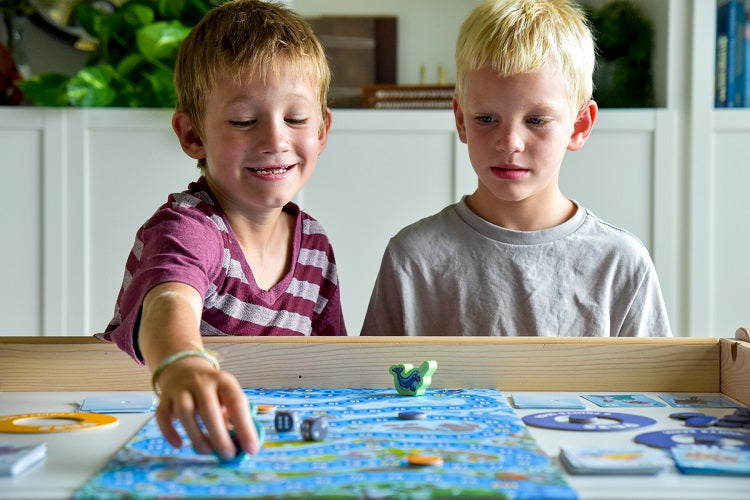
Educational Gaming with Arctic Riders
Arctic Riders featured on The Tabletop Family blogThe Tabletop Family blog, dedicated to family gameplay, shares why Arctic Riders is one of the best math-focused games for elementary-aged kids that they have ever played.
-
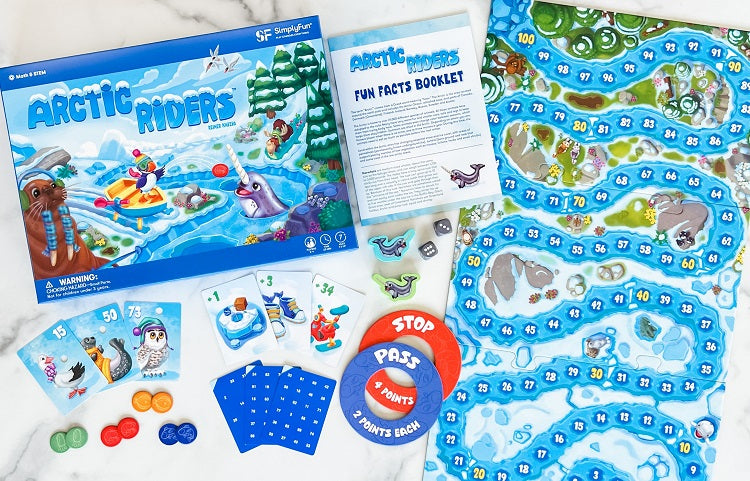
Holiday Gift Guide: We Love It!
Arctic Riders featured in Birmingham Parent MagazineElena Epstein, director of the National Parenting Product Awards includes Arctic Riders in Birmingham Parent Magazine‘s Holiday Gift Guide.
-
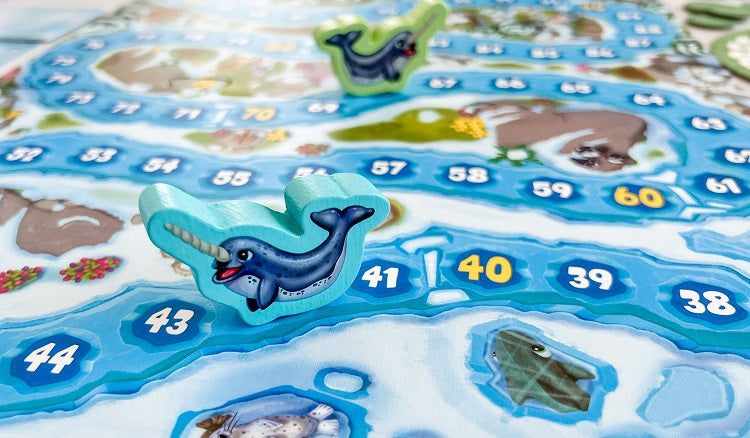
Solve Equations & Feed Narwhals in Arctic Riders!
Arctic Riders on the SimplyFun blogThis exciting math game teaches addition, subtraction, solving equations, and decision-making skills while showcasing the animals of the Arctic!
-
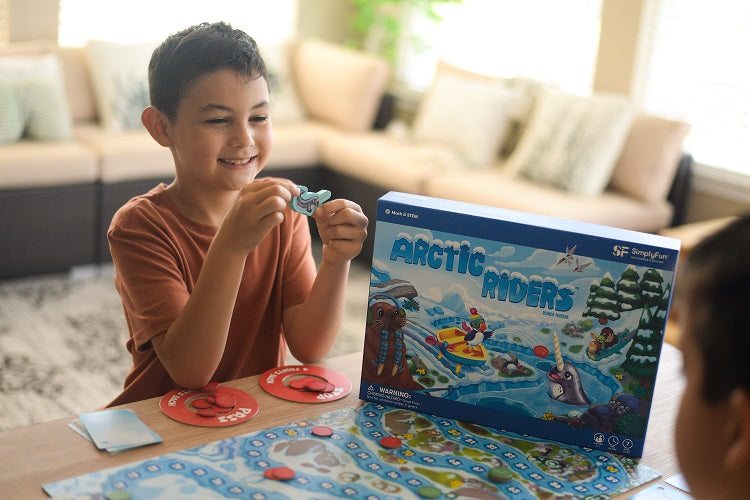
Game On! Arctic Riders is a Holiday Gift Pick
Arctic Riders featured in L.A. Parent MagazineElena Epstein, director of the National Parenting Product Awards includes Arctic Riders in L.A. Parent Magazine‘s 2023 gift guide.
- Choosing a selection results in a full page refresh.
- Opens in a new window.

